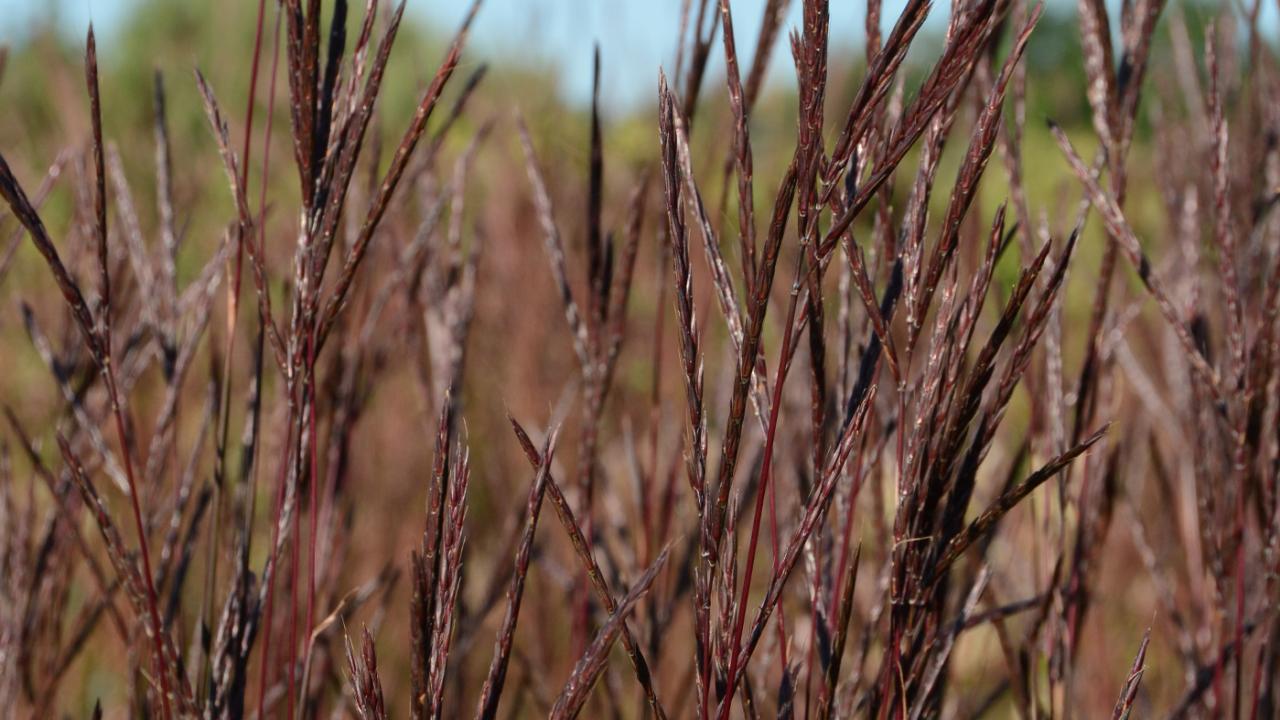

An Evaluation Study of Hardy Ornamental Grasses
An Evaluation Study of Hardy Ornamental Grasses | Issue 43 2018
Richard G. Hawke, Plant Evaluation Manager and Associate Scientist
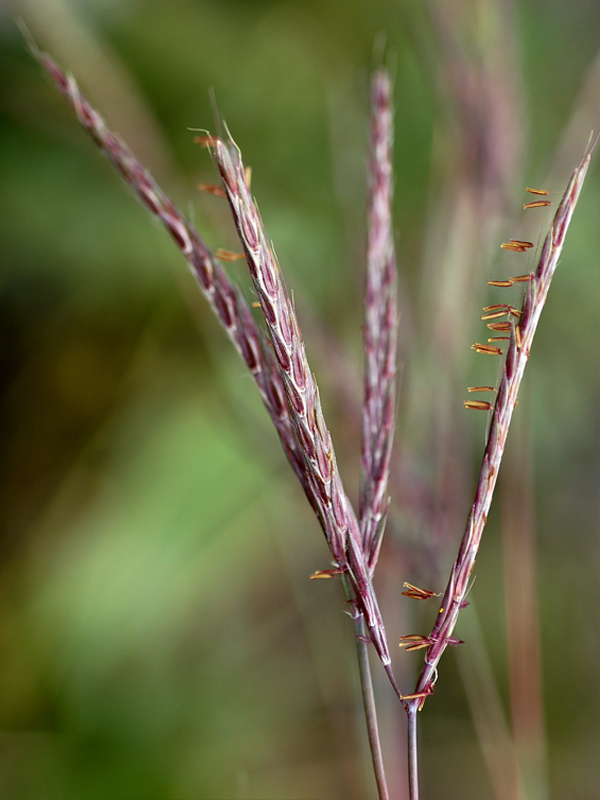
Andropogon gerardii
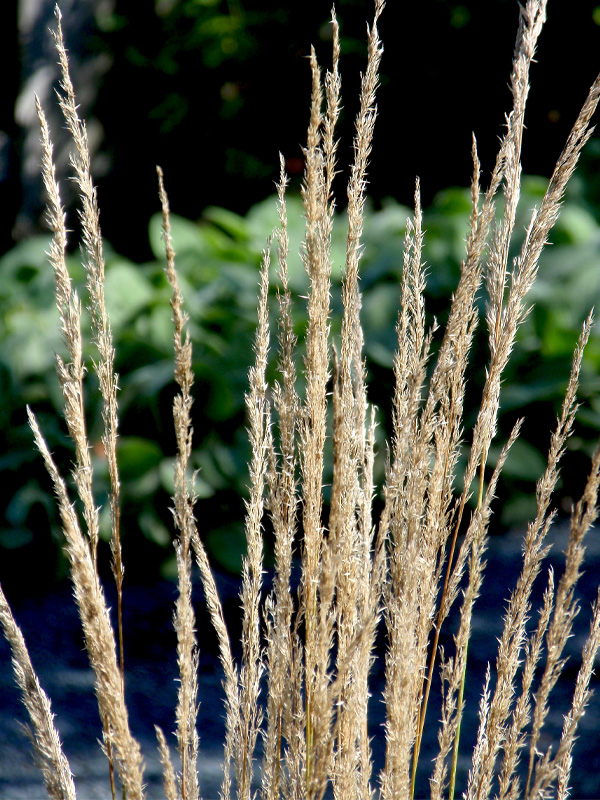
Calamagrostis xacutiflora 'Overdam'
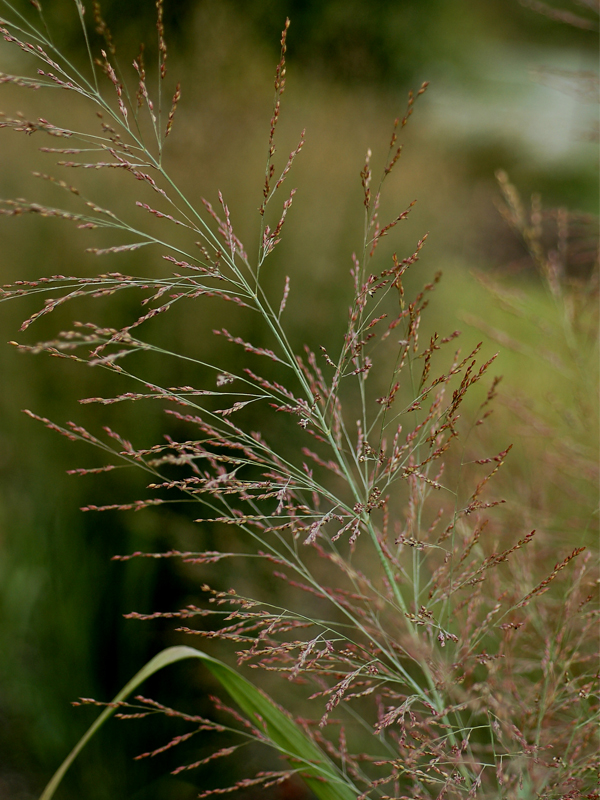
Panicum virgatum 'Dallas Blues'
Ornamental grasses is a collective term that distinguishes grasses planted in gardens and other amenity landscapes from those growing in natural places. A variety of grasses are used horticulturally—both natives and exotics—and range in size from gigantic pampas grass (Cortaderia selloana) to diminutive blue fescue (Festuca glauca). In the gardening world, ornamental grasses are commonly cited as companion plants for perennials regardless of their specific traits, which gives the impression that grasses are universal, thus interchangeable. A closer look reveals their distinctive traits in an array of shapes, sizes, colors, and textures that complement and mingle beautifully with perennials and woody plants alike.
The grass family, Poaceae or Gramineae, is one of the largest families of flowering plants with more than 600 genera and 10,000 species encompassing the true grasses, which includes bamboos. Grasses grow on every continent and are part of all major biomes. As pioneer plants, grasses are often adapted to survival in extreme conditions such as heat, cold, drought, low fertility, or toxicity. Beyond their ornamental uses, grasses are crucial to our existence—many grasses are important cereal grains such as wheat, corn, millet, rice, rye, oats, and barley.
There is a similarity and simplicity that grasses share, but leaves, habits, and flowers can vary greatly from one species to another. Grass stems, or culms, are typically rounded and herbaceous—bamboos are specialized grasses whose culms have a woody character. Grass leaves consist of three parts: blade, sheath, and ligule. The flattened blade extends out from the sheath, which clasps the culm at a joint or node. The ligule, often marked by a row of hairs, is at the juncture of the blade and sheath. Blades are usually narrow with parallel venation and pointed tips, and can be short to quite long. Leaf margins may be smooth or lined with sharp teeth.
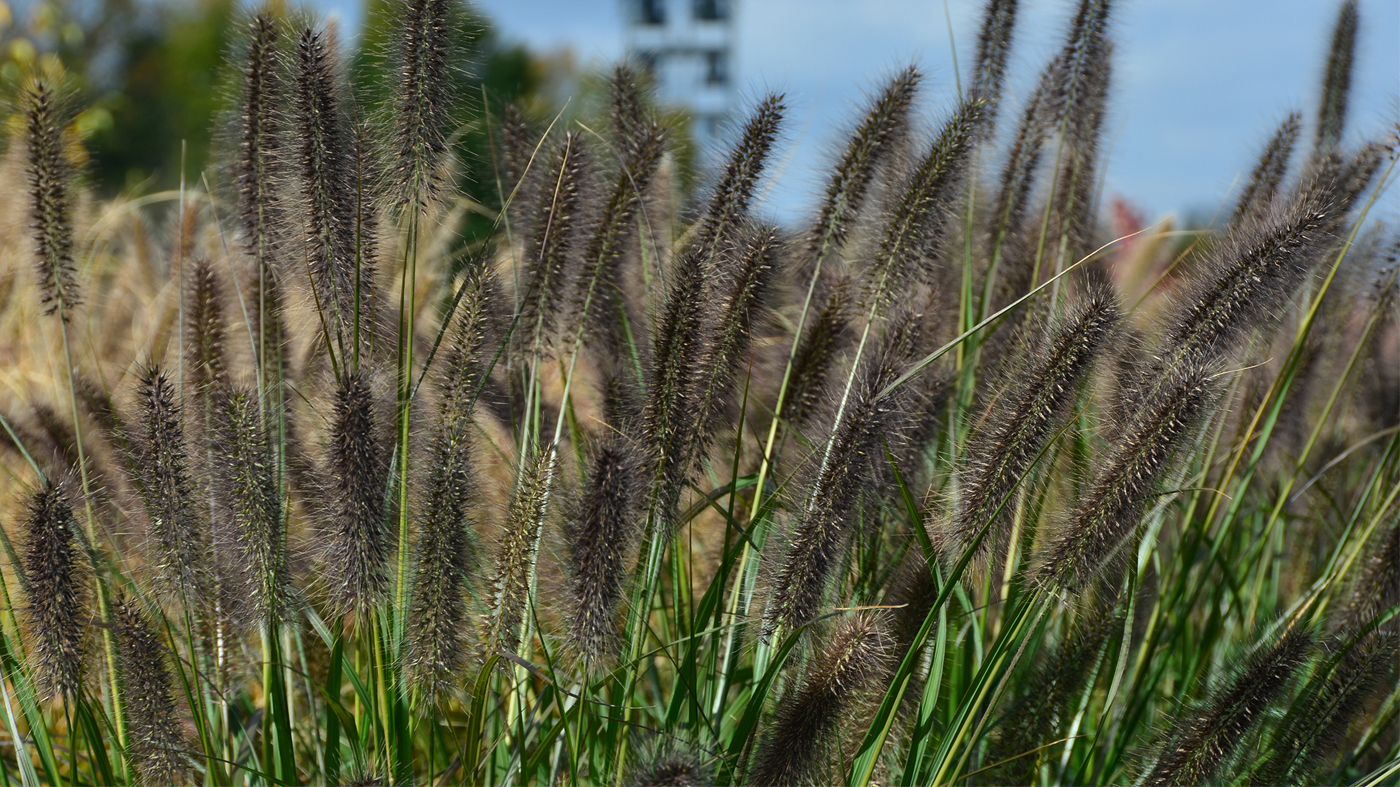
Pennisetum alopecuroides 'Red Rocket'
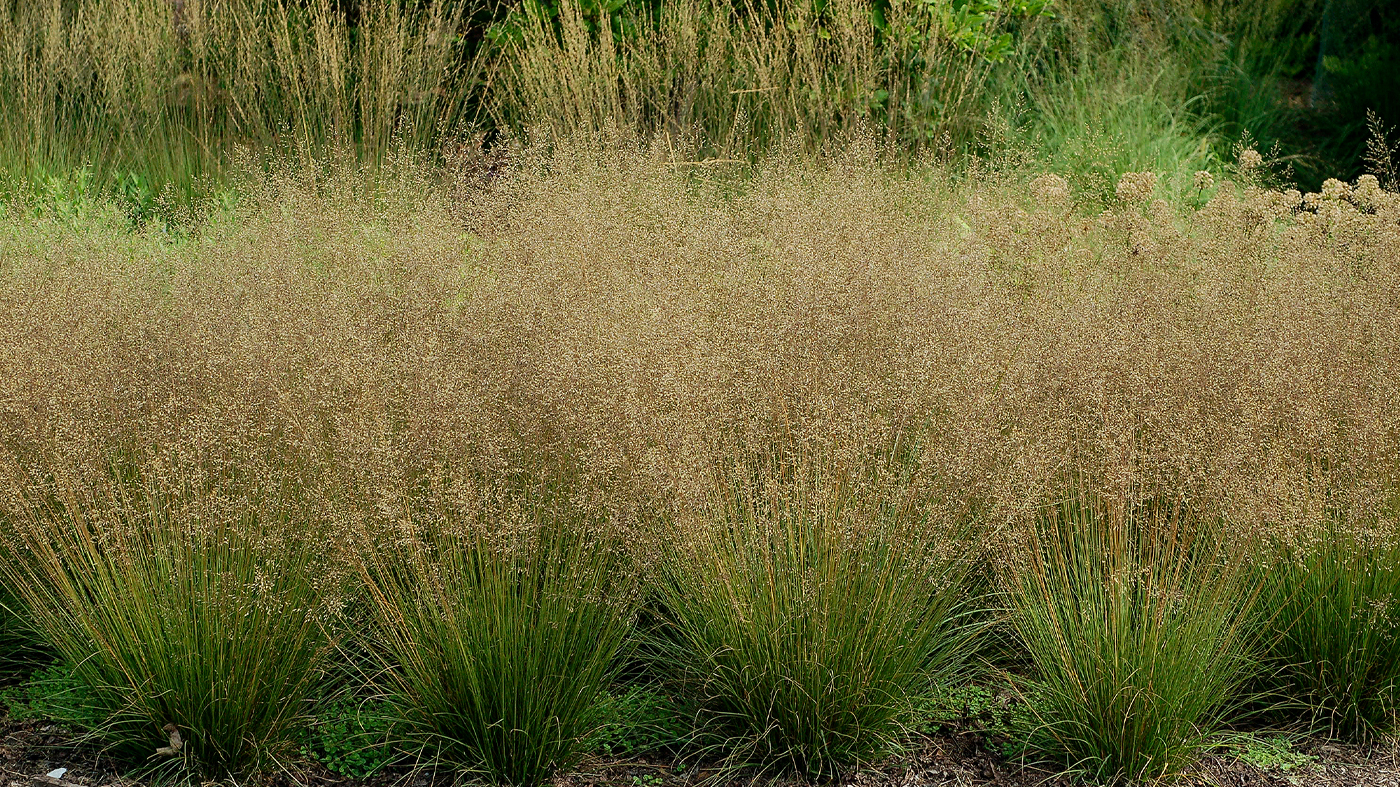
Sporobolus heterolepis 'Tara'
Grass habits are characterized by two main traits. First, grasses have either running or clumping growth forms. Running grasses such as giant reed (Arundo donax) and buffalo grass (Buchloe dactyloides) spread by rhizomes or stolons, which may spread aggressively and take over more space than intended. Hakone grass (Hakonechloa macra) is a runner that grows so slowly it might be mistaken for a clumping grass. In contrast, clumping grasses form discrete non-rhizomatous crowns and while they make excellent accent plants, they can be massed to great effect too. Second, grasses are either warm- or cool-season plants. Warm-season grasses break dormancy late in the spring, put on the greatest growth in the warmest weather, and flower later in the summer. This group includes fountain grass (Pennisetum alopecuroides), switch grass (Panicum virgatum), prairie dropseed (Sporobolus heterolepis), and big and little bluestems (Andropogon gerardii and Schizachyrium scoparium, respectively). Cool-season grasses emerge earlier in the spring and may stall out during hot, dry weather. Rainfall and cooler autumnal temperatures re-invigorate cool-season grasses such as feather reed grass (Calamagrostis spp.), grama (Bouteloua spp.), and purple moor grass (Molinia caerulea).
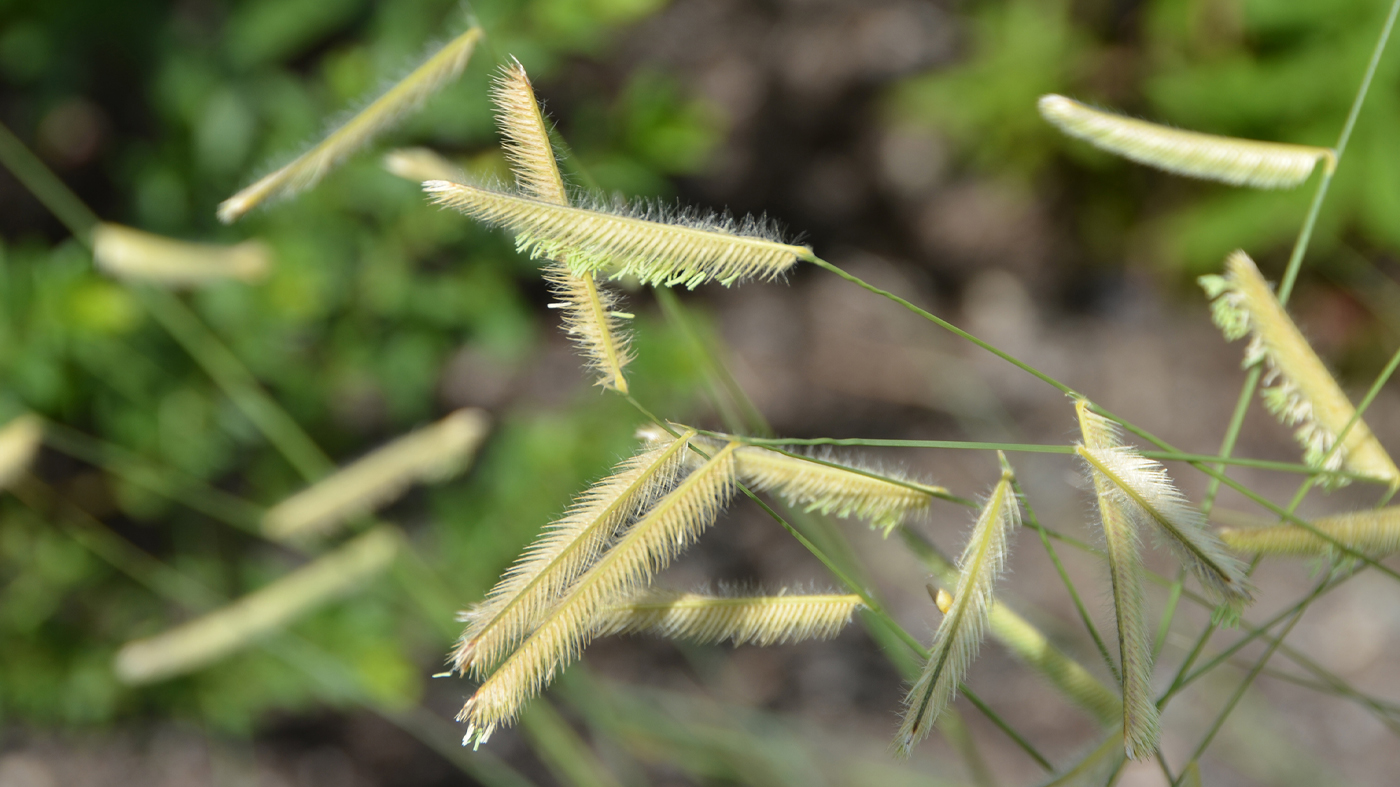
Bouteloua gracilis 'Blonde Ambition'
Grass inflorescences are either simple or compound in structure, and commonly located at the terminal of the culm. Spikes, racemes, or panicles are types of simple inflorescences, while compound inflorescences are made up of a combination of one or more of the three simple types. Inflorescences can be loose to constricted in shape, quite sizable with many florets, and often take on different colors and forms as seeds ripen. The inflorescences as a whole rather than the typically nondescript individual florets provides the floral show. Each floret consists of the flower—stamens and pistil—and two bracts that enclose the flower. The outer, lower bract is the lemma, and the inner, upper bract is the palea. One or more florets together is a spikelet, which is subtended by two glumes that may be tipped with long bristlelike appendages called awns. For example, fountain grass florets feature significant awns. Grass flowers are often wind-pollinated, and the seeds or grains are typically dispersed by wind and rain, or transported by mammals, birds, and insects.
Most grasses prefer full sun and moist, well-drained soils but many are adaptable to drier conditions and are drought-tolerant once established. Prairie dropseed, big bluestem, and little bluestem are good examples of grasses that tolerate droughty conditions. On the other hand, purple moor grass requires consistent moisture in hot, dry periods as it is not drought-tolerant—it grows naturally in moors, bogs, fens, and grasslands throughout Europe to western Siberia. Some grasses prefer some level of shade; for example, morning sun will enhance the variegated and golden-leaved forms of Hakone grass but too much sunlight may burn the foliage. Fertilizing grasses is unnecessary, and results in lush growth that may become over ly vigorous and floppy.
Grasses are generally easy to grow and typically require minimal maintenance. Culms should be cut down to 4 inches or so annually in late fall to early winter, or in late winter to early spring before new leaves emerge. Late season clean-up is recommended for purple moor grass because although the colorful stems may remain erect for much of the winter, they are as likely to flop, dislodge, and look a mess before winter begins. Grasses left up overwinter provide structure, color, movement, and shelter for wildlife. The tool used to cut grasses depends on the plant size and density of the crown. Hand pruners, hedge shears, or saws are all options for smaller grasses; electric hedge shears, weedwhips, and chainsaws can be helpful on larger grasses such as eulalia (Miscanthus spp.) and switch grass. Shorter grasses with looser crowns such as Hakone grass are easily managed with pruners or by running a lawn mower over them. Leaf margins can be razor-sharp and cause skin irritation and itching, so heavy gloves and long sleeves are recommended when working around grasses. Deadheading is a personal choice and only necessary to discourage reseeding.
Grasses do not need to be regularly divided unless clumps are overgrown or have developed hollow centers—every five to seven years is a good rule of thumb. Divide clumps in the spring before the new leaves emerge. If that window is missed, actively growing grasses can be cut back by a third before dividing or transplanting. A wellsharpened axe or garden spade may be needed to divide dense clumps into smaller sections; healthy divisions should be replanted immediately. Purple moor grass can be difficult to divide because of its dense root system and how slowly it reestablishes. Hakone grass is shallow-rooted and prone to frost-heaving, so spring division and transplanting is recommended to ensure plants are well-rooted by fall.
Grasses can be affected by a few diseases, and excess moisture seems to be the catalyst in many cases. Rusts can be troublesome in wet, humid weather; root and crown rots are problems in poorly drained soils; and excessively wet cultural conditions, especially in heavily shaded sites, may promote anthracnose and leaf spots. Planting in full sun— where appropriate—and well-drained soils, and minimizing overhead irrigation are helpful in keeping diseases at bay. Most grasses are touted as deer-resistant; however, ground-burrowers such as gophers and voles can feed on roots throughout the year, and rabbits may be troublesome too.
Whether large or small, singly or grouped, grasses are equally brilliant in home gardens or corporate campuses, and are integral in the matrix of prairies and meadows. For structure, motion, sound, light, and even scent, grasses are unparalleled in their sensory effects, and their charm is tenfold when massed. Grasses animate landscapes with the supple dance of stems, the sibilant rustle of leaves, and the play of light through airy flowerheads.
List of Sections
The Evaluation Study
The Performance Report
Top-rated Grasses
Summary
References
Armitage, A.M. 2008. Herbaceous Perennial Plants, Third Edition. Champaign, IL: Stipes Publishing L.L.C.
Darke, R. 2007. The Encyclopedia of Grasses for Livable Landscapes. Portland, OR: Timber Press
Madeja, G., Umek, L., and Havens, K. 2012. "Differences in Seed Set and Fill of Cultivars of Miscanthus Grown in USDA Cold Hardiness Zone 5 and Their Potential for Invasiveness." Journal of Environmental Horticulture: March 2012, Vol. 30, No. 1, pp. 42-50.
Rice, G., editor-in-chief. 2006. American Horticultural Society Encyclopedia of Perennials. New York, NY: DK Publishing, Inc.
The Plant Evaluation Program is supported by the Woman’s Board of the Chicago Horticultural Society and the Searle Research Endowment.
Plant Evaluation Notes© are periodic publications of the Chicago Botanic Garden.
The Chicago Botanic Garden is one of the treasures of the Forest Preserves of Cook County.
-
A variety of ornamental grasses—109 taxa in total—were grown and evaluated at the Chicago Botanic Garden (USDA Hardiness Zone 5b, AHS Plant Heat- Zone 5) in full-sun and shade evaluation gardens between 2006 and 2017. All grasses were evaluated for their adaptability to the growing conditions of the trial sites; resistance or susceptibility to diseases and pests; cold hardiness and winter survivability; and ornamental attributes such as foliar quality, flower production, habit vigor, and winter character. Reseeding capacity and potential weediness were assessed by monitoring seedlings in and around the trial plots.
A minimum of three plants of each taxon were grown in proximity to each other for easy comparison of ornamental traits and landscape performance. The full-sun evaluation garden was openly exposed to wind in all directions and received at least ten hours of sun daily during the growing season, which averaged 177 days per year for the trial period (see Table 1). The clay-loam soil had a pH of 7.4, and although typically well-drained, the soil retained excess moisture for short periods in summer and winter. Trial beds were raised 8 inches above the surrounding turf to improve soil drainage. In the shade evaluation garden, light exposures in various sites ranged from morning sun and afternoon shade to full-day shade; none of the grasses were in full sun after midday. In all cases, the trial beds were naturally shaded by mature trees including red oak, hawthorn, maple, and birch. A cedar fence enclosing the trial site provided some wind protection from all directions. The well-drained, clay-loam soil had a 7.5 pH during the trial period.
Maintenance practices were kept to a minimum, thereby allowing the plants to thrive or fail under natural conditions. Trial beds were irrigated via overhead sprinklers as needed, mulched with composted leaves each summer, and regularly weeded. Moreover, plants were not fertilized, winter-mulched, or chemically treated for insect or disease problems. The grasses were observed for habit quality and ornamental interest in winter; therefore, stems were not cut down until late winter or early spring before new growth began.
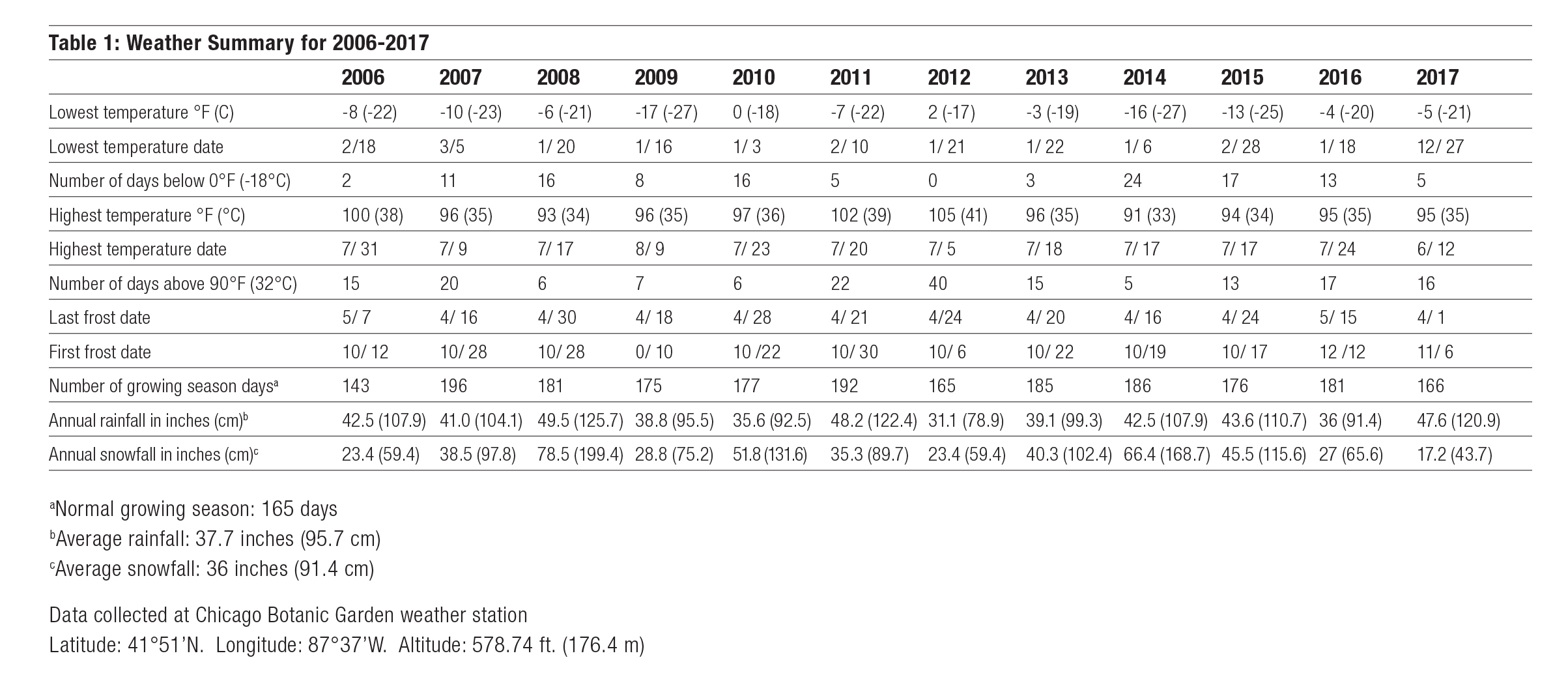
A variety of ornamental grasses—109 taxa in total—were grown and evaluated at the Chicago Botanic Garden (USDA Hardiness Zone 5b, AHS Plant Heat- Zone 5) in full-sun and shade evaluation gardens between 2006 and 2017. All grasses were evaluated for their adaptability to the growing conditions of the trial sites; resistance or susceptibility to diseases and pests; cold hardiness and winter survivability; and ornamental attributes such as foliar quality, flower production, habit vigor, and winter character. Reseeding capacity and potential weediness were assessed by monitoring seedlings in and around the trial plots.
A minimum of three plants of each taxon were grown in proximity to each other for easy comparison of ornamental traits and landscape performance. The full-sun evaluation garden was openly exposed to wind in all directions and received at least ten hours of sun daily during the growing season, which averaged 177 days per year for the trial period (see Table 1). The clay-loam soil had a pH of 7.4, and although typically well-drained, the soil retained excess moisture for short periods in summer and winter. Trial beds were raised 8 inches above the surrounding turf to improve soil drainage. In the shade evaluation garden, light exposures in various sites ranged from morning sun and afternoon shade to full-day shade; none of the grasses were in full sun after midday. In all cases, the trial beds were naturally shaded by mature trees including red oak, hawthorn, maple, and birch. A cedar fence enclosing the trial site provided some wind protection from all directions. The well-drained, clay-loam soil had a 7.5 pH during the trial period.
Maintenance practices were kept to a minimum, thereby allowing the plants to thrive or fail under natural conditions. Trial beds were irrigated via overhead sprinklers as needed, mulched with composted leaves each summer, and regularly weeded. Moreover, plants were not fertilized, winter-mulched, or chemically treated for insect or disease problems. The grasses were observed for habit quality and ornamental interest in winter; therefore, stems were not cut down until late winter or early spring before new growth began.

-
The trial of ornamental grasses began in June 2006 with the planting of 34 taxa of Miscanthus spp. Seventy-five additional taxa, representing an assortment of grass species, were added to the trials between 2007 and 2015. In all, 109 taxa were grown in either the full-sun or shade evaluation gardens. Five taxa were grown in shady sites including Calamagrostis xacutiflora ‘Overdam’, Chasmanthium latifolium ‘River Mist’, Diarrhena americana, Hakonechloa macra ‘Stripe it Rich’, and H. macra ‘Sunny Delight’. The majority of grasses were evaluated for a minimum of four years; the nine taxa in the trial for only three years were Andropogon gerardii ‘Rain Dance’, A. ternarius, Festuca ‘Cool as Ice’, Miscanthus sinensis var. condensatus ‘Cabaret’, Panicum virgatum ‘RR1’, P. virgatum ‘Squaw’, Pennisetum alopecuroides ‘Foxtrot’, Schizachyrium scoparium ‘Little Indian’, and Sorghastrum nutans ‘Skywalker’.
All grasses were assessed for cultural adaptability to the soil and environmental conditions of the trial sites; winter hardiness and survivability; disease and pest issues; and ornamental qualities associated with foliage, floral display, and plant habits. Final performance ratings are based on foliage and habit quality, flower production, health and vigor, and winter hardiness. Table 3 shows the years in the trial, observed plant traits, and overall ratings for 75 taxa. In the end, performance ratings were not assigned to any Miscanthus taxa, as they are deemed potentially invasive and not recommended for cultivation (see sidebar on Miscanthus spp. Trial: Fecundity and Potential Invasiveness).
The trial of ornamental grasses began in June 2006 with the planting of 34 taxa of Miscanthus spp. Seventy-five additional taxa, representing an assortment of grass species, were added to the trials between 2007 and 2015. In all, 109 taxa were grown in either the full-sun or shade evaluation gardens. Five taxa were grown in shady sites including Calamagrostis xacutiflora ‘Overdam’, Chasmanthium latifolium ‘River Mist’, Diarrhena americana, Hakonechloa macra ‘Stripe it Rich’, and H. macra ‘Sunny Delight’. The majority of grasses were evaluated for a minimum of four years; the nine taxa in the trial for only three years were Andropogon gerardii ‘Rain Dance’, A. ternarius, Festuca ‘Cool as Ice’, Miscanthus sinensis var. condensatus ‘Cabaret’, Panicum virgatum ‘RR1’, P. virgatum ‘Squaw’, Pennisetum alopecuroides ‘Foxtrot’, Schizachyrium scoparium ‘Little Indian’, and Sorghastrum nutans ‘Skywalker’.
All grasses were assessed for cultural adaptability to the soil and environmental conditions of the trial sites; winter hardiness and survivability; disease and pest issues; and ornamental qualities associated with foliage, floral display, and plant habits. Final performance ratings are based on foliage and habit quality, flower production, health and vigor, and winter hardiness. Table 3 shows the years in the trial, observed plant traits, and overall ratings for 75 taxa. In the end, performance ratings were not assigned to any Miscanthus taxa, as they are deemed potentially invasive and not recommended for cultivation (see sidebar on Miscanthus spp. Trial: Fecundity and Potential Invasiveness).
-
More than 60 percent of grasses in the trial received high overall ratings; Miscanthus spp. are not included in this reckoning. Twenty-two grasses received five-star excellent ratings: Andropogon gerardii ‘Blackhawks’ and ‘Dancing Wind’; Molinia caerulea ssp. arundinacea ‘Bergfreund’, ‘Cordoba’, ‘Fontäne’, ‘Skyracer’, ‘Transparent’, and ‘Windspiel’; M. caerulea ssp. caerulea ‘Dauerstrahl’, ‘Heidebraut’, ‘Moorflamme’, ‘Moorhexe’, and ‘Poul Petersen’; Panicum ‘Bad Hair Day’, P. virgatum ‘Heavy Metal’, and ‘Northwind’; Pennisetum alopecuroides ‘Desert Plains’ and ‘Red Head’; Schizachyrium scoparium ‘Carousel’, ‘Jazz’, and ‘Prairie Munchkin’; and Sporobolus heterolepis ‘Tara’. Additionally, 25 taxa received four-star good ratings.
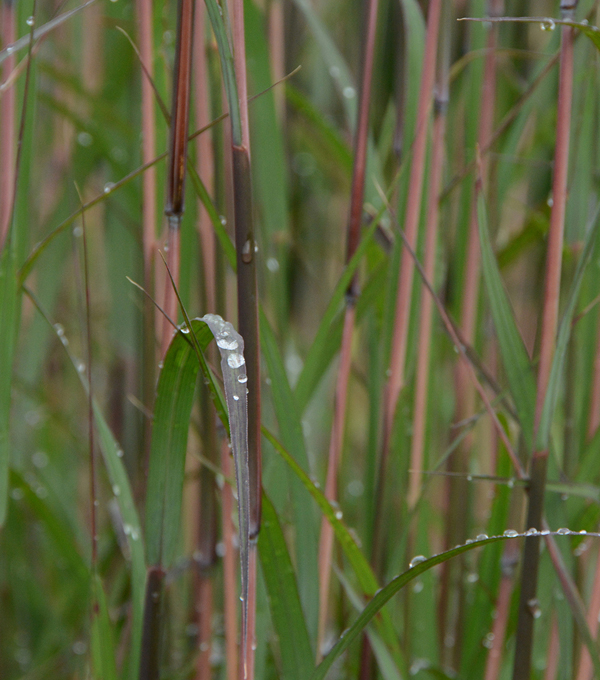
Andropogon gerardii 'Blackhawks'
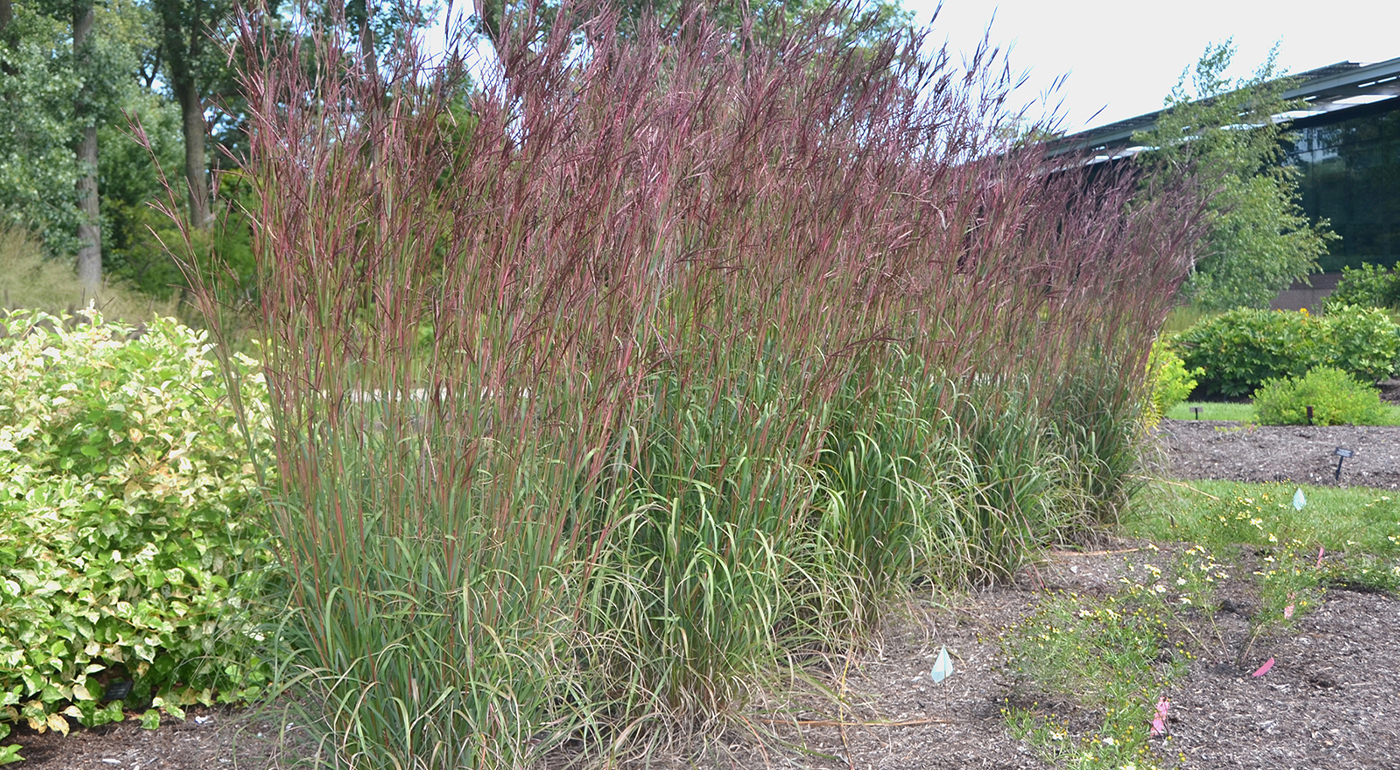
Andropogon gerardii 'Dancing Wind'
Andropogon gerardii – big bluestem, turkey foot
Big bluestem, once the dominant grass of midwestern tallgrass prairies, is native throughout Eastern North America and west to the Rocky Mountains. It is a warm-season grass that generally acts like a clumper—it actually spreads slowly by rhizomes and also reseeds freely. Big bluestem is adaptable to a wide range of growing conditions and is drought-tolerant once established. Full sun and well-drained soils are best to maintain strong, upright habits; culms may flop in shade, especially in moist, fertile soils. Many selections have been made for livestock grazing but a number of garden-worthy cultivars with improved fall color have been introduced in recent years.
‘Blackhawks’ is a newer selection featuring exceptionally dark burgundy leaves and stems—the darkest of any big bluestem in the trial. Leaves emerged green in spring and gradually turned fully purple in the summer. By late summer, the basal leaves, rigid stems, and three-parted flowers— resembling a turkey’s foot—were all dark burgundy. Although color persisted in the stems and inflorescences into early winter, the basal leaves were mostly tan and dry by early autumn. At 62 inches tall, ‘Blackhawks’ was compact by comparison to other cultivars, which can reach to 8 feet tall. ‘Blackhawks’ was introduced by Brent Horvath, Intrinsic Perennial Gardens, Hebron, Illinois.
‘Dancing Wind’, while not as deeply hued as ‘Blackhawks’, provided a nice color show. For much of the summer, the bright green leaves were purple-tipped to purple-flushed, eventually turning mostly purple in September before tanning in early October. Beginning in late July and continuing well into autumn, the colorful culms—purple-red and coppery—dominated the ornamental display along with the deep red-purple inflorescences. ‘Dancing Wind’ had a robust erect habit, twice as tall as broad—75 inches tall and 38 inches wide. ‘Red October’, an earlier introduction also from Brent Horvath, had a comparable appearance to ‘Dancing Wind’, except that its red-bronze culms turned brilliant scarlet after frost in October.

Molinia caerulea ssp. arundinacea 'Bergfreund'

Molinia caerulea ssp. arundinacea 'Cordoba'
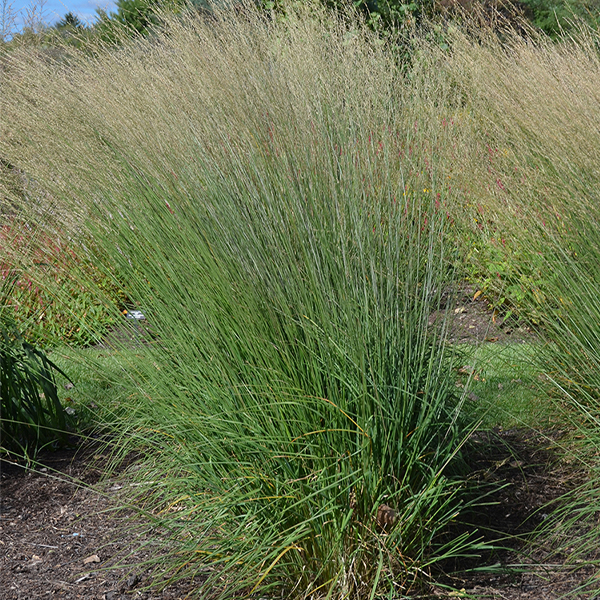
Molina caerulea ssp. caerulea 'Dauerstrahl'
Molinia caerulea ssp. arundinacea and Molinia caerulea ssp. caerulea – purple moor grass
The wide, arching leaves of Molinia caerulea ssp. arundinacea are coarse compared to the narrow, vertical foliage of the typically shorter subspecies caerulea. Purple moor grass is deciduous, which means that it sheds its leaves in autumn. However, our observations showed that the leaves and stems did not abscise as neatly as the term implies; rather, leaves remained attached and often fully upright or gradually fell away as winter crept on. In some winters, we observed heavy snow toppling plants and aiding in breaking off the leaves and flower stems—subspecies caerulea cultivars stood up to heavy snow better than the broad-leaved selections.
Research at Kew Gardens in England established that the different foliar traits of the two types are cultural rather than genetic, which effectively invalidates their distinction as subspecies. In the wild, the two subspecies grow together; however, the broad leaves and increased vigor of plants distinguished as ssp. arundinacea is due to unusually moist, fertile soils. Conversely, plants designated as ssp. caerulea are found growing on drier edges of the same bogs and moors. This information has not caught up with nomenclature, so the names reflect what is commonly found in nurseries and gardening publications. Purple moor grass prefers moist, cool soils, so supplemental water in the hottest weather ensures plants remain healthy.
Despite coarse-textured foliage, the tall arching flower stems of ‘Bergfreund’ were graceful. Dense green-and-purple flower clusters, to 25 inches long, matured to coppery seedheads by late September. In early November, the floral stems were pinky orange as the leaves turned yellow. Like other cultivars, the amber color of the winter stems was only a shade lighter than the brighter autumnal show. At 68 inches tall with flowers, ‘Bergfreund’ was a mid-sized purple moor grass.
‘Cordoba’ was a strong performer for eight years in the trial and became the one to beat. The arching flower culms rose to 84 inches tall above green leafy mounds. Its strong architectural form was enhanced by copious large purple-green flowerheads, each to 18 inches long. Tawny seedheads shattered late in the season, leaving silvery skeletons atop ocher stems. ‘Cordoba’ turned vivid golden-yellow in autumn and typically peaked in mid-November—in some winters this show lasted into February.
‘Dauerstrahl’ featured mainly vertical fine-textured green leaves but the outermost leaves were often arching. Dense foliar mounds with upright, slightly arched culms reached 50 inches tall and 57 inches wide. The purple and green flowers matured to golden tan seedheads before shattering in early November. The golden yellow leaves and tannish yellow culms held their color into winter.

Molinia caerulea ssp. arundinacea ‘Fontäne’
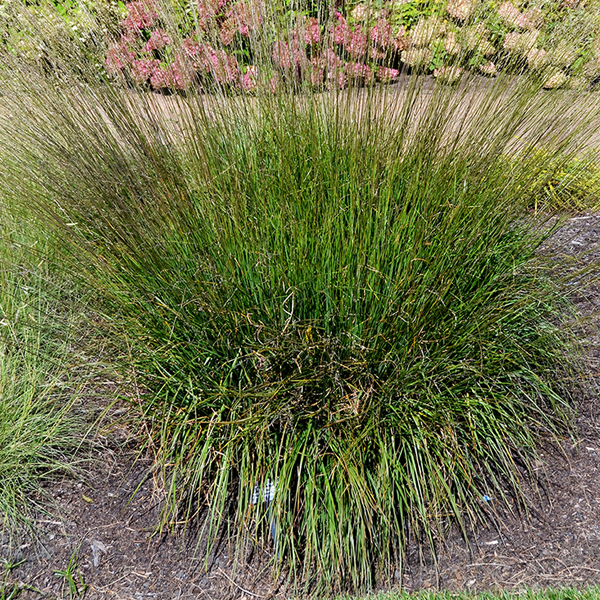
Molinia caerulea ssp. caerulea ‘Heidebraut’

Molinia caerulea ssp. caerulea ‘Moorhexe’

Molinia caerulea ssp. caerulea 'Poul Petersen'
‘Fontäne’ was one of a few cultivars with darker purple flowers—the exserted anthers provided the color. Low mounded clumps, to 24 inches tall, were topped with arched flower stems reaching nearly 6 feet tall and 5 feet wide. In autumn, the seedheads were a toasted golden-tan and the combination of mahogany stems and yellow leaves gave ‘Fontäne’ a golden coppery glow.
The tiny purple-black anthers of ‘Heidebraut’ were darker than any other selection and created an impressive display viewed in mass. The flowers began blooming just as they poked out of the foliage but eventually the culms rose further above the lush green mounds. ‘Heidebraut’ had a strong upright habit, reaching 58 inches tall with flowers.
The muted golden yellow culms were the real autumnal show—the color held even after the leaves shriveled in early November. And as the tan fruits shattered, the silvery skeletons of the inflorescences added some winter interest.
‘Moorflamme’ was one of the shorter selections at 46 inches tall yet still a foot taller than anticipated. The upright, finetextured green leaves turned a muted golden yellow and the culms turned bronze in mid-autumn. With flowers, its dense bushy habit seemed almost perfectly round in outline.
‘Moorhexe’ featured narrow dark green leaves and dark purple-green flowers that aged to golden tan in mid-August.
After shattering in autumn, the spent inflorescences had an argent quality that was accentuated when backlit by morning or late-day sunlight. In September, flower stems took on orange and bronze tones before turning deep bronze in mid-October. ‘Moorhexe’ had a fairly narrow upright habit to 48 inches tall and 55 inches wide.
At 44 inches tall, ‘Poul Petersen’ was notable in its stoutness—it was one of the shortest of the group with a bushy vase-shaped habit and slightly arching green leaves. Feathery flowerheads of dark purple and green made a pleasing show in early July followed by tan seedheads in late summer. The clear golden yellow fall color was comparable to other cultivars.
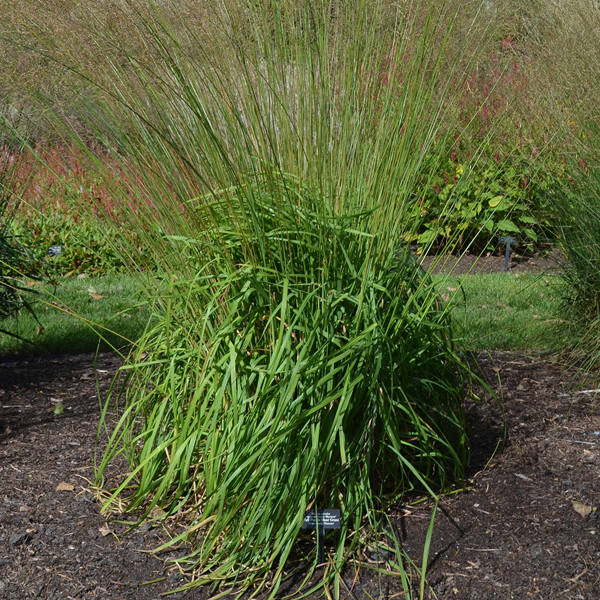
Molina caerulea ssp. arundinacea 'Skyracer'
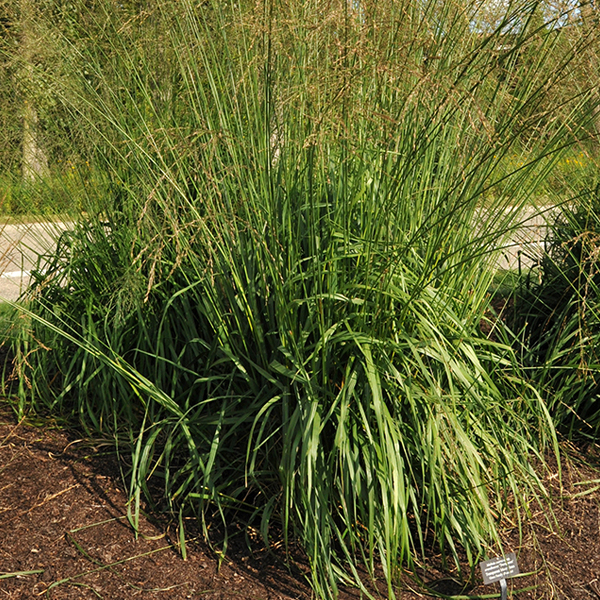
Molinia caerulea ssp. caerulea 'Transparent'

Molinia caerulea ssp. arundinacea ‘Windspiel’
At nearly 7 feet tall, ‘Skyracer’ was an impressive grass, both in its soaring height and the movement of the supple stems. Culms took on a pinkish tinge in early November while the arching leaves were still green. The leaves eventually turned golden to tawny. ‘Skyracer’ is similar in appearance to ‘Windspiel’ but with a slightly narrower habit.
In leaf, ‘Transparent’ was coarse with a mix of vertical and arching leaves that formed a robust bushy mound to 3 feet tall. The green-and-purple plumelike inflorescences ripened to golden tan, and flower stems turned yellow in late summer well before the leaves changed to soft golden yellow in November. At peak, ‘Transparent’ was 85 inches tall and 56 inches wide across the floral crown.
‘Windspiel’ was similar in habit character and size to other tall selections such as ‘Skyracer’ and ‘Karl Foerster’. While not precisely a diagnostic trait, its coarsetextured foliage was not as arching as other cultivars. Large, fine-textured inflorescences with purple-pink and green flowers were held on slender culms, which turned golden tan in August, long before the leaves eventually turned golden yellow late in the fall. At 80 inches tall, ‘Windspiel’ was one of the tallest cultivars but still 20 inches shorter than ‘Staefa’.

Panicum ‘Bad Hair Day’
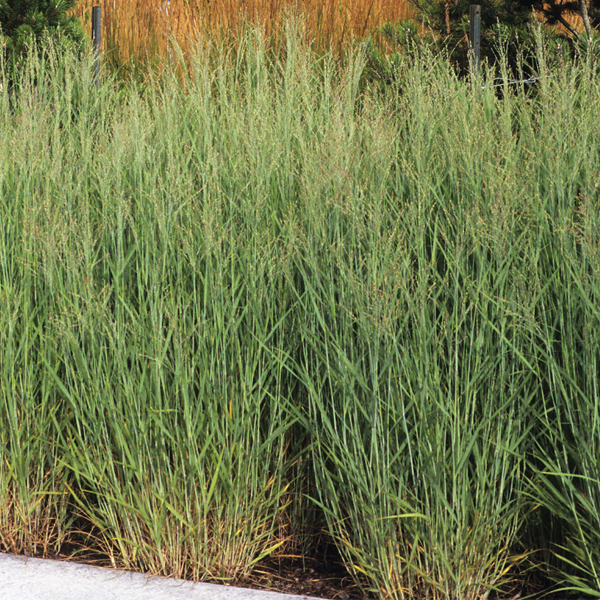
Panicum virgatum 'Heavy Metal'
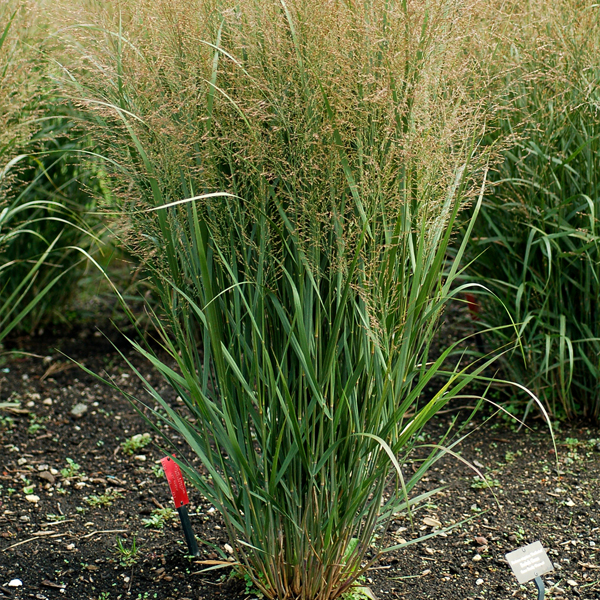
Panicum virgatum 'Northwind'
Pancium virgatum - switch grass, panic grass
Switch grass is native over much of North America except for the coastal western states, and is quite adaptable to a variety of cultural situations. Leaves can be green, blue-green, or silvery blue-green, and may be red- to purple-accented. Switch grass tends to be more columnar in form and usually remains upright through winter— seeds are a winter food source for birds so stems should not be cut back until spring. Relaxed or flopped culms were the typical cause for a lower rating in the trial. Crown injury and plant losses in winter were occasionally observed but were a minor issue overall.
The strongly upright stems of ‘Bad Hair Day’—to 71 inches tall—gave it a narrow silhouette, while the grayish green leaves were mostly pendulous. The late-summer cascading inflorescences were much denser than other switch grasses—their substantial size resulted in broad crowns to 88 inches wide. The weeping inflorescences swaying in the wind presented an ever-changing whimsical appearance that inspired its name. The foliage and inflorescences turned light yellowish brown and persisted into late autumn. ‘Bad Hair Day’ is a hybrid developed by Dr. Jim Ault at the Chicago Botanic Garden.
‘Heavy Metal’ featured distinctive bluegray leaves paired with strictly upright culms. In late summer, pinkish flowers in copious airy panicles topped the vertical stems. The ripened purple fruit display was as ornamental as the floral show. The striking yellow fall color eventually turned beige and culms stayed upright for the winter. ‘Heavy Metal’ averaged 58 inches tall and 56 inches wide measured across the top when in full flower.
‘Northwind’ was consistently one of the best switch grasses trialed. The olive green leaves, with blue-green undersides, seemed slightly drab by comparison to color-forms such as ‘Dallas Blues’, RUBY RIBBONS™, and ‘Shenandoah’. However, when heavy rains and strong winds toppled some switch grasses, the rigid stems of ‘Northwind’ stood firm to 75 inches tall with flowers—even the leaf tips pointed straight up rather than curving downward like most other cultivars. Clouds of yellow flowers, followed by purple fruits, were held just above the lush foliage in late summer. Leaves turned yellow in fall before fading to tan for the winter. ‘Northwind’ was the 2014 Perennial Plant of the Year.
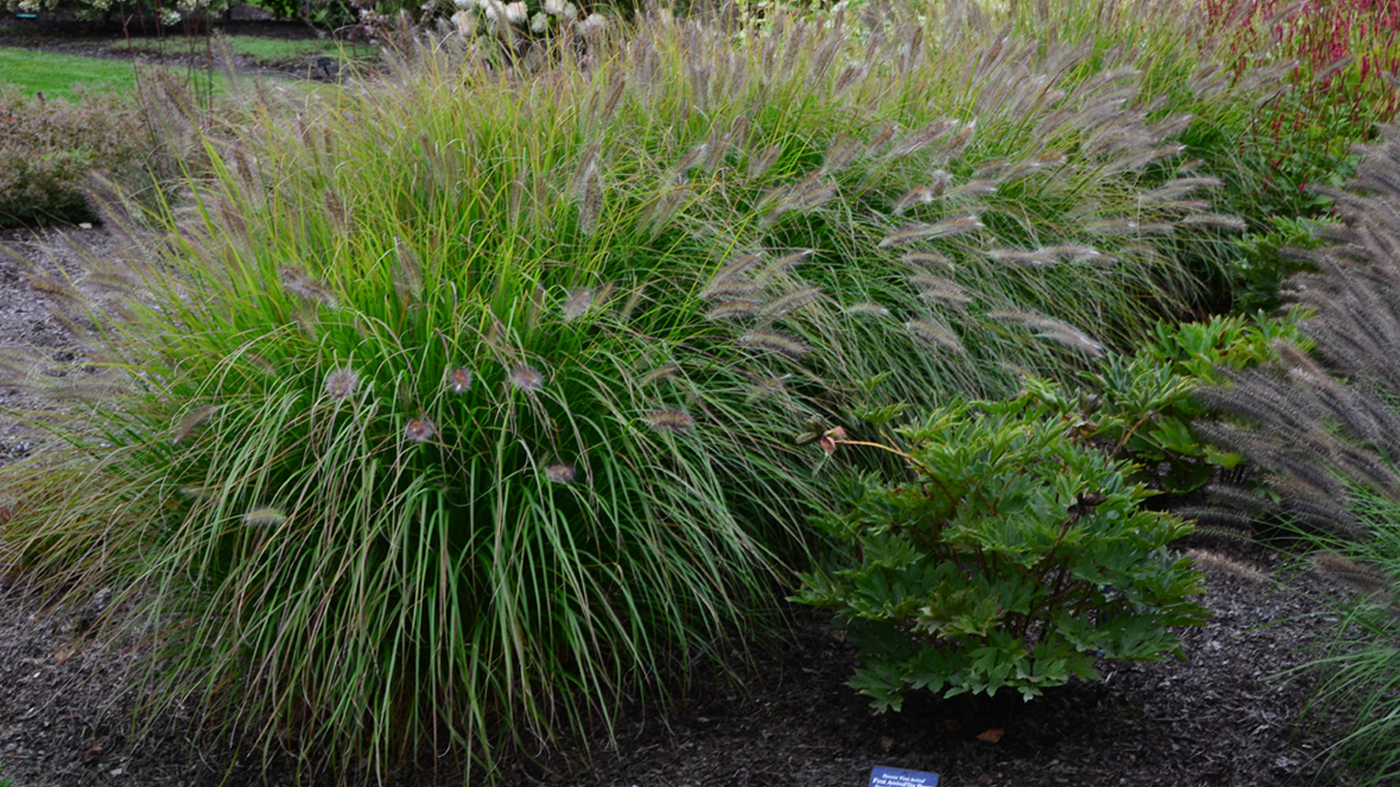
Pennisetum alopecuroides ‘Desert Plains’

Pennisetum alopecuroides 'Red Head'
Pennisetum alopecuroides – fountain grass
Fountain grass is a warm-season grass from eastern Asia and is represented in cultivation by a number of cultivars selected for plant size and/or flower color. Gracefully arching leaves form a mounding habit and the distinctive inflorescences feature long bristly awns. Fountain grass self-seeds liberally, and while abundant seedlings were found in all years of the trial, it was impossible to attribute seedlings to a specific cultivar. Crown injury or death were the main reasons for reduced ratings; the species is commonly listed as marginally hardy in USDA Zone 5. Fountain grass is easily grown in average soils in full sun to partial shade—flower production decreases in too much shade.
‘Desert Plains’ is touted as being exceptionally cold-hardy and its performance in the trial proved that to be true. It originated in western Michigan as a seedling of ‘Cassian’ and was selected for its improved habit, increased flowering, and fall color. At 50 inches tall and 72 inches wide, ‘Desert Plains’ had a robust bushy habit with long arching green leaves tipped with purple. In fall, the foliage turned orange and bronze. The large purple and tan flowers—6 inches long and 2 inches wide—were produced profusely just atop the leaves in late August, and remained ornamental until shattering in mid- to late November.
‘Red Head’ was selected for its early red flowers; only Pennisetum orientale ‘Karley Rose’ bloomed earlier. Its graceful arching habit, more fountainlike than other cultivars in the trial, was topped with red-purple flowers from late July into October. The bristly inflorescences—9 inches long and 3 inches wide—looked like giant woolly bear caterpillars, and held their color well into October before fading and shattering. Golden yellow fall color adorned the long slender leaves into early winter.
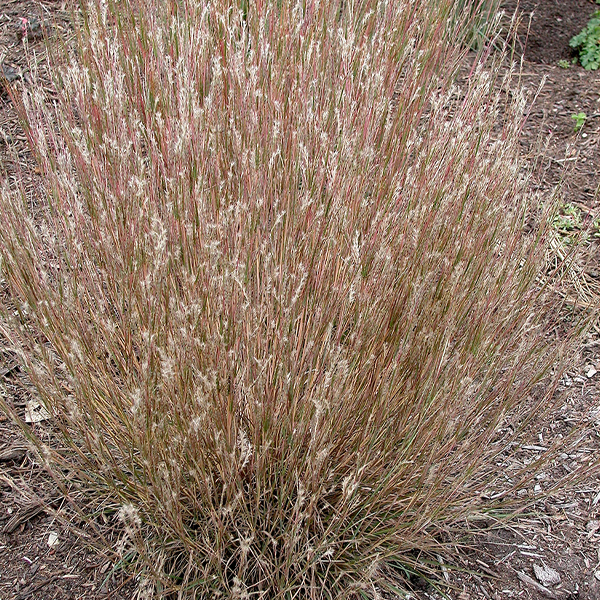
Schizachyrium scoparium 'Carousel'

Schizachyrium scoparium 'Jazz'
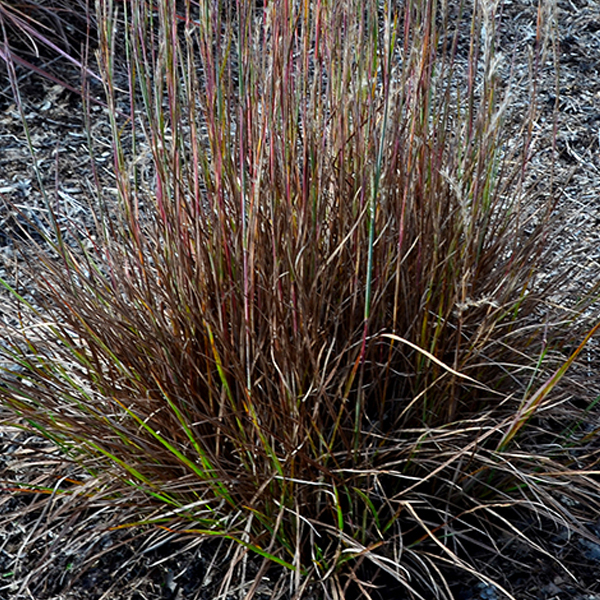
Schizachyrium scoparium ‘Prairie Munchkin’
Schizachyrium scoparium – little bluestem
Little bluestem is native to much of North America, and like big bluestem, was a dominant grass of the tallgrass prairie biome. Little bluestem prefers full sun, is tolerant of average to dry soils, and shows good drought resistance once established, but does not like overly wet conditions or deep shade. Little bluestem is clump-forming with blue-green to green leaves. Insignificant purplish flowers are borne along the culms but the showy silvery seedheads persist for a long time. Plants that remained upright provided ornamental interest in form, color, and texture over winter. Low-rated taxa tended to have floppy culms, and/or significant crown injury or plant losses in winter.
‘Carousel’ is a compact selection from Don Boehm, an Illinois nurseryman who also introduced ‘Prairie Munchkin’. Blue-green leaves—not as silvery blue as ‘The Blues’ or ‘Jazz’—were red-purple-tinged and held on reddish culms. ‘Carousel’ was a kaleidoscope of softly muted colors throughout the seasons—at varying times blue-green, red-purple, pink, copper, and mahogany. Wispy silvery inflorescences peppered along the culms were ethereal in autumnal light and remained ornamental into winter. A broad, bowl-shaped habit—as tall as wide—marked ‘Carousel’ as different from other little bluestems, and its slender stems stayed upright through winter.
‘Jazz’, an introduction from Brent Horvath, was most comparable to ‘The Blues’ in leaf color. Both had striking silvery blue-green foliage but ‘Jazz’ featured purple accents. At 36 inches tall and 30 inches wide, ‘Jazz’ was a foot shorter than ‘The Blues’ with much sturdier stems. ‘Jazz’ was erect at all times including winter, whereas ‘The Blues’ usually flopped early in the summer. The late-season silvery seedheads were followed by a strong purple fall color; ‘The Blues’ turned orange and red.
‘Prairie Munchkin’ is a shorter selection with sturdy stems that reached 22 inches tall in the trial but can be expected to be 36 inches tall. The silvery blue culms changed to purple in fall at the same time that the bluish green leaves turned a mix of purple, orange, and bronze. The stems remained erect in winter, and like other little bluestems, ‘Prairie Munchkin’ should be cut to the ground in late winter before new leaves emerge.

Sporobolus heterolepis 'Tara'
Sporobolus heterolepis – prairie dropseed
Prairie dropseed is a fine-textured native grass with distinctly arching threadlike leaves that form a fountainesque habit. Open floral panicles rise above foliar mounds on slender stalks to three feet tall in late summer. The heady fragrance of the flowers—variably described as popcorn, cilantro, or coriander—is a signature trait of prairie dropseed. Leaves take on coppery orange hues in the fall and fade to a paler version in winter. Prairie dropseed is drought-tolerant and adaptable to a wide range of growing conditions, from clay to rocky soils. It is native to a large portion of Eastern North America, and has become popular massed as a lawn substitute.
‘Tara’ is an outstanding selection of prairie dropseed discovered by Roy Diblik, Northwind Perennial Farm, Burlington, Wisconsin. ‘Tara’ features many of the strong characteristics of the species such as superior drought-tolerance and fragrant flowers, while being distinctive in its own right. The fine-textured green leaves were upright rather than arching, giving ‘Tara’ more of a vase-shaped habit than the species. Slender floral stems held airy panicles of pink flowers in August; the seedheads were darker brown than the species, adding another level of late-season interest. The pungent aroma of the flowers impregnated the late summer air. The threadlike leaves and stems turned a vibrant red-orange in the fall, and remained upright in winter except under heavy snow.
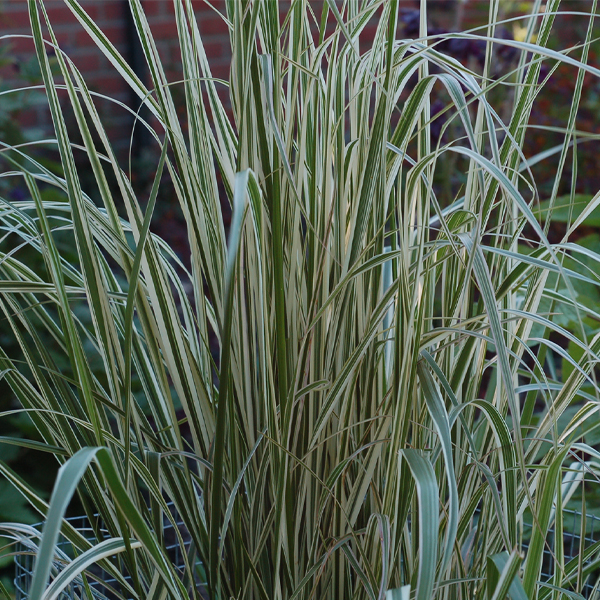
Calamagrostis xacutiflora 'Overdam'

Chasmanthium latifolium ‘River Mist’
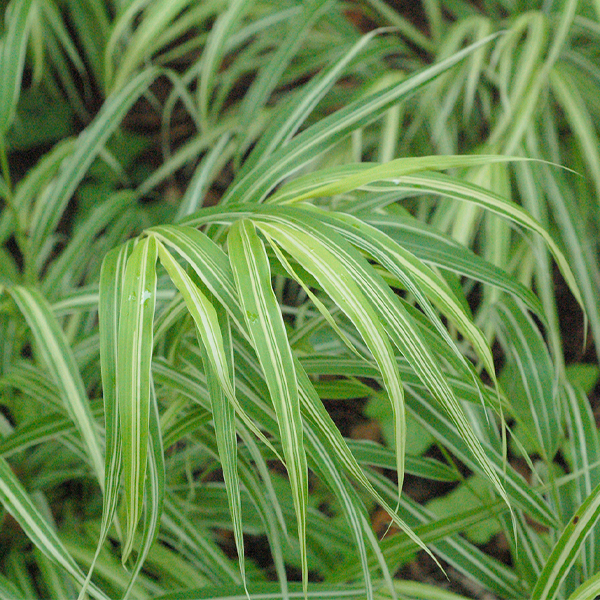
Hakonechloa macra ‘Stripe it Rich’
Other ornamental grasses in the trial
Several grasses were represented in the trial by only one or two taxa. In each instance, the grasses came to the trial through an unsolicited donation and therefore, were not part of a larger comparative scheme. Although not all of the grasses were top-rated, Bouteloua gracilis ‘Blonde Ambition’, Calamagrostis xacutiflora ‘Overdam’, Chasmathium latifolium ‘River Mist’, Diarrhena americana, Hakonechloa macra ‘Stripe it Rich’, Sorghastrum nutans ‘St. Louis’, and Sporobolus wrightii ‘Windbreaker’ received four-star good ratings.
The fine-textured, blue-green-leaved mounds of Bouteloua gracilis ‘Blonde Ambition’ were blanketed in a profusion of chartreuse flowers in midsummer. The curious blonde seedheads of blue grama—held horizontally on the culms like pennants—remained intact and colorful through winter. ‘Blonde Ambition’ averaged 36 inches tall and 42 inches wide. ‘Blonde Ambition’ is adaptable to a range of soil types but as a warm-season grass, it was slow to emerge in the spring.
Calamagrostis xacutiflora ‘Overdam’ is a variegated form of feather reed grass, with creamy white and green leaves. Feathery plumes of silvery pink flowers in early summer constricted and turned tan for much of the summer and fall. ‘Overdam’ had a pronounced narrowly fastigiate habit when young; over time plants reached a broader 38 inches wide and 48 inches tall. Culms remained upright through winter.
The first year in the trial was challenging for Chasmanthium latifolium ‘River Mist’ due to repeated rabbit browsing. The frosty white-and-green variegated leaves were striking but not as visually impressive as photographs in nursery catalogs. ‘River Mist’ was clump-forming, and at 17 inches tall and 14 inches wide, was about half the expected height and width. The whimsical nodding seedheads were long-lasting on the plant. The species generously self-seeds but no seedlings of ‘River Mist’ were observed in the evaluation garden. Indian woodoats grows in sun or shade but dappled shade is best for this variegated selection; our plants received morning sun and afternoon shade.
Diarrhena americana, American beakgrain, is a native grass with glossy bright green leaves and insignificant greenish flowers in midsummer. Leaves turned golden in the fall and held tan in the winter. Plants crept by rhizomes to form a dense colony in the moist, shady evaluation plot. The plants were undemanding beyond cutting down culms in late winter; occasional rabbit browsing was noted.
Hakonechloa macra ‘Stripe it Rich’ was slow-growing, but developed a full mounded habit by the third year. Hakone grass is among the most graceful of grasses, with cascading foliage and a rhizomatous habit. Golden yellow leaves, striped with white, need some sunlight—preferably morning sun—to remain vibrant. In our trial, the plants were grown in deep shade so leaves were lime green by midsummer. Leaves turned russet to tawny in the fall, and stems remained mostly upright in winter. Plants were caged to protect from rabbit browsing.

Sorghastrum nutans ‘St. Louis’

Sporobolus wrightii ‘Windbreaker’
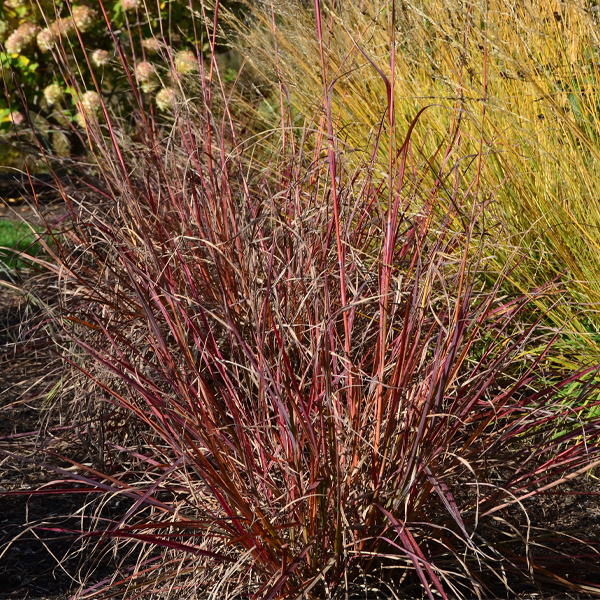
Andropogon gerardii ‘Red October’
Sorghastrum nutans ‘St. Louis’ had arching, purple-tipped blue-green leaves and a robust bushy habit with upright stems to 76 inches tall. In autumn, culms turned burgundy-bronze and leaves turned orange- red, eventually aging to tan with a tinge of bronze. The flowers looked orange from a distance due to the yellow and bronze anthers; the foot-long inflorescences were erect to arching and about 2 inches wide. Striking deep bronze-brown fruit followed the flowers. Indian grass is best grown in full sun, is adaptable to a wide range of soils including heavy clay, and is drought-tolerant once established.
Sporobolus wrightii ‘Windbreaker’, an introduction of big sacaton from New Mexico, was developed as a wind barrier for commercial vegetable fields and as a native substitute for pampas grass. ‘Windbreaker’ was a robust clump-forming grass, 80 inches tall with flowers and 60 inches wide. Gray-green leaves formed generous foliar mounds to 50 inches tall. Large, green pyramidal flower clusters rose high over the foliage in summer, and remained erect through winter. Big sacaton is drought tolerant and adaptable to high alkaline, saline, and poorly drained soils in full sun.
Several factors such as winter injury, inferior habits, disease or pest problems, and/or reduced flower production contributed to lower overall ratings. Most genera suffered some degree of crown injury or plant loss on one or more taxa, regardless of their USDA hardiness zone rating. Crown loss to one or more plants of a taxon in one year only was the most prevalent winter injury. The following taxa had some degree of crown injury during the trial; the year that injury occurred is noted in parentheses: Bouteloua gracilis ‘Blonde Ambition’ (2016), Festuca ‘Cool as Ice’ (2017), Molinia caerulea (2015), Molinia caerulea ssp. caerulea ‘Variegata’ (2016), Panicum virgatum ‘Rostrahlbusch’ (2008), P. virgatum ‘Shenandoah’ (2010), Pennisetum alopecuroides ‘Foxtrot’ (2007, 2008), P. orientale ‘Karley Rose’ (2007), S. scoparium ‘MinnBlueA’ (2013), and Sporobolus wrightii ‘Windbreaker’ (2014).
Several taxa suffered the loss of multiple plants in one or more winters, including Andropogon ternarius (2012, two plants dead and 2013, three plants dead), A. virginicus (2013, two plants dead and 2014, three plants dead), and Hakonechloa macra ‘Sunny Delight’ (2012, one plant dead and 2013, one plant dead). Taxa with both crown injury and plant losses in winter included Pennisetum alopecuroides ‘Ginger Love’ (2016, crown loss and one plant dead), P. alopecuroides ‘Red Rocket’ (2016, crown loss and two plants dead), Schizachyrium scoparium ‘Little Indian’ (2009, one plant dead; 2010, crown loss and two plants dead), S. scoparium ‘Prairie Blues’ (2009, crown loss and three plants dead; 2010, two plants dead), and S. scoparium ‘Standing Ovation’ (2014, crown loss and one plant dead). In the case of A. ternarius, A. virginicus, and S. scoparium ‘Prairie Blues’, all plants died before the end of their trial. With the exception of Andropogon ternarius and P. orientale ‘Karley Rose’—all listed for Zone 6 or warmer—the grasses are cold-hardy in Zone 5 or colder. Split-beard broomsedge, A. ternarius, is a southern native of well-drained sandy or gravelly soils, so both cultural conditions and low temperatures likely contributed to its poor performance. Conversely, A. virginicus is native to northern areas so moist soil conditions in winter rather than cold temperatures was likely the main cause of plant loss.
Inferior plant habits were most commonly due to lax or floppy stems, although in some instances irregular or weak plants resulting from winter crown injury was the cause. The following grasses received a reduced rating based primarily on inferior plant habits: Molinia caerulea ssp. caerulea ‘Variegata’, Panicum amarum ‘Dewey Blue’, P. virgatum ‘Amber Waves’, P. virgatum ‘Badlands’, P. virgatum ‘Rostrahlbusch’, P. virgatum ‘RR1’, P. virgatum ‘Squaw’, P. virgatum ‘Strictum’, P. virgatum ‘Thundercloud’, P. virgatum ‘Trailblazer’, P. virgatum ‘Warrior’, Pennisetum alopecuroides ‘Red Rocket’, P. orientale ‘Karley Rose’, Schizachyrium scoparium ‘Blaze’, S. scoparium ‘The Blues’, and Sorghastrum nutans ‘Skywalker’.
Grasses in the trial were largely diseaseand pest-free. Andropogon gerardii ‘Red October’ and Calamagrostis xacutiflora ‘Overdam’ experienced moderate and severe rust infections, respectively. Rabbits were occasional pests during the trial period but no regular grazing patterns were observed except for the repeated browsing of Chasmanthium latifolium ‘River Mist’. A hardware cloth cage was erected to allow the plants to grow unhindered.
Flower production was high—greater than 80 percent—for the majority of ornamental grasses; however, production levels of less than 60 percent was the primary or a contributing cause of lower overall performance ratings for a number of taxa, including Diarrhena americana, Pennisetum alopecuroides ‘Burgundy Bunny’, Schizachyrium scoparium ‘Little Indian’, and S. scoparium ‘Standing Ovation’. Reduced flower production in combination with inferior habits and/or winter injury, resulted in fair to poor ratings for Andropogon ternarius, A. virginicus, Panicum virgatum ‘Amber Waves’, P. virgatum ‘RR1’, P. virgatum ‘Trailblazer’, Schizachyrium scoparium ‘Little Indian’, and S. scoparium ‘Prairie Blues’.
The issue of weediness and potential invasiveness was an observational criterion from the start of the trial. Seedlings of various grasses were observed in evaluation beds but in each case, were not readily attributable to a specific taxon. Fountain grass seedlings (Pennisetum spp.) were regularly and prodigiously noted in the turf paths adjacent to their plots, and were periodically discovered in the crowns of other nearby ornamental grasses. Although infrequently observed, Schizachyrium scoparium seedlings were likewise most commonly found growing within the crowns of other grasses. Cultivars of Miscanthus sinensis were by far the most prolific seeders, especially in proximity to the parent plants. Switch grass and purple moor grass seedlings were generally uncommon.
Miscanthus spp. Trial: Fecundity and Potential Invasiveness
For years, Miscanthus sinensis and its cultivars were believed to bloom too late in the season in northern Illinois to produce viable seed. While warmer parts of the country have long seen the invasive potential of M. sinensis, it was presumed that the late bloom period, i.e. seed maturation, effectively rendered it safe from becoming invasive in northern areas. Miscanthus sinensis is an exotic species, so if it or any of its many cultivars escapes cultivation into natural landscapes, as they have done in milder climates, they become invasive. This goes beyond simply being weedy—M. sinensis has naturalized in 25 states, the District of Columbia, and Ontario, and is on numerous state invasive plant lists such as Illinois, Alabama, Connecticut, and Georgia. The spread of invasive species is the second greatest threat to biodiversity following habitat destruction. In the Uni ted States, economic losses from all invasive species are estimated to be $120 billion annually, with invasive plants accounting for at least $35 billion.
Rather than relying on anecdotal information, scientists at the Chicago Botanic Garden looked at the question of potential invasiveness directly. In a five-year study, it was discovered that many cultivars of Miscanthus sinensis produced viable seed; and therefore, were not only fertile but potentially invasive. From 2006 through 2010, 34 taxa were grown and monitored for plant vigor, bloom period, and flower production. As the trial proceeded, an increasing number of seedlings carpeted the trial plots and adjacent landscapes each spring. By casual observation, it was impossible to determine what cultivar(s) were responsible for the seedlings, but obviously some or many of the selections were producing viable seed. In October 2010, inflorescences from each of the 34 taxa were x-rayed to see if embryos were present in the seeds. X-ray analysis is an efficient and non-destructive method of assessing seed quality and viable seed quantity. A good x-ray image reveals details of seed fill, insect infestation, and the size or absence of an embryo. The x-rays confirmed that fecundity—the number of viable seeds per plant—varied widely, from as few as 497 for ‘Dixieland’ to 349,327 for ‘Kleine Silberspinne’. Viable seed was expected for the earliest blooming cultivars such as ‘Ferner Osten’, ‘Adagio’, and ‘Nippon’, but even latebloomers such as ‘Gracillimus’, ‘Morning Light’, and ‘Dixieland’ produced seed, albeit at lower quantities.
The study showed that seed production and viability varied significantly between cultivars (see Table 2), thus demonstrating the importance of evaluating all cultivars for invasive potential. Flowering phenology is important as well. Many of the less fecund cultivars were late-flowering, indicating that they may not have had time to complete their life cycle in our climate. Cultivars vary significantly in fecundity and fecundity can increase over time for this generally long-lived perennial. In the study, only Miscanthus sinensis ‘Hinjo’ and ‘Silberpfeil’, M. sinensis var. condensatus ‘Cabaret’, and M. xgiganteus produced no viable seed. However, these results must be considered cautiously as seed production could potentially still occur as plants mature or are grown in longer growing seasons; for example, ‘Hinjo’ set seed in a study conducted at the University of Minnesota, which is located in USDA Zone 4. Miscanthus xgiganteus appears to be a sterile triploid so should be safe anywhere it is grown. In addition, M. sinensis var. condensatus ‘Cabaret’ was considered marginally hardy in our location and was not observed for a complete evaluation cycle.
In light of these findings, the Chicago Botanic Garden removed all Miscanthus spp. plantings from its display gardens between 2010 and 2017. Gardeners and green industry professionals are encouraged to look to the many other ornamental grasses, especially native species, as substitutes.

More than 60 percent of grasses in the trial received high overall ratings; Miscanthus spp. are not included in this reckoning. Twenty-two grasses received five-star excellent ratings: Andropogon gerardii ‘Blackhawks’ and ‘Dancing Wind’; Molinia caerulea ssp. arundinacea ‘Bergfreund’, ‘Cordoba’, ‘Fontäne’, ‘Skyracer’, ‘Transparent’, and ‘Windspiel’; M. caerulea ssp. caerulea ‘Dauerstrahl’, ‘Heidebraut’, ‘Moorflamme’, ‘Moorhexe’, and ‘Poul Petersen’; Panicum ‘Bad Hair Day’, P. virgatum ‘Heavy Metal’, and ‘Northwind’; Pennisetum alopecuroides ‘Desert Plains’ and ‘Red Head’; Schizachyrium scoparium ‘Carousel’, ‘Jazz’, and ‘Prairie Munchkin’; and Sporobolus heterolepis ‘Tara’. Additionally, 25 taxa received four-star good ratings.

Andropogon gerardii 'Blackhawks'

Andropogon gerardii 'Dancing Wind'
Andropogon gerardii – big bluestem, turkey foot
Big bluestem, once the dominant grass of midwestern tallgrass prairies, is native throughout Eastern North America and west to the Rocky Mountains. It is a warm-season grass that generally acts like a clumper—it actually spreads slowly by rhizomes and also reseeds freely. Big bluestem is adaptable to a wide range of growing conditions and is drought-tolerant once established. Full sun and well-drained soils are best to maintain strong, upright habits; culms may flop in shade, especially in moist, fertile soils. Many selections have been made for livestock grazing but a number of garden-worthy cultivars with improved fall color have been introduced in recent years.
‘Blackhawks’ is a newer selection featuring exceptionally dark burgundy leaves and stems—the darkest of any big bluestem in the trial. Leaves emerged green in spring and gradually turned fully purple in the summer. By late summer, the basal leaves, rigid stems, and three-parted flowers— resembling a turkey’s foot—were all dark burgundy. Although color persisted in the stems and inflorescences into early winter, the basal leaves were mostly tan and dry by early autumn. At 62 inches tall, ‘Blackhawks’ was compact by comparison to other cultivars, which can reach to 8 feet tall. ‘Blackhawks’ was introduced by Brent Horvath, Intrinsic Perennial Gardens, Hebron, Illinois.
‘Dancing Wind’, while not as deeply hued as ‘Blackhawks’, provided a nice color show. For much of the summer, the bright green leaves were purple-tipped to purple-flushed, eventually turning mostly purple in September before tanning in early October. Beginning in late July and continuing well into autumn, the colorful culms—purple-red and coppery—dominated the ornamental display along with the deep red-purple inflorescences. ‘Dancing Wind’ had a robust erect habit, twice as tall as broad—75 inches tall and 38 inches wide. ‘Red October’, an earlier introduction also from Brent Horvath, had a comparable appearance to ‘Dancing Wind’, except that its red-bronze culms turned brilliant scarlet after frost in October.

Molinia caerulea ssp. arundinacea 'Bergfreund'

Molinia caerulea ssp. arundinacea 'Cordoba'

Molina caerulea ssp. caerulea 'Dauerstrahl'
Molinia caerulea ssp. arundinacea and Molinia caerulea ssp. caerulea – purple moor grass
The wide, arching leaves of Molinia caerulea ssp. arundinacea are coarse compared to the narrow, vertical foliage of the typically shorter subspecies caerulea. Purple moor grass is deciduous, which means that it sheds its leaves in autumn. However, our observations showed that the leaves and stems did not abscise as neatly as the term implies; rather, leaves remained attached and often fully upright or gradually fell away as winter crept on. In some winters, we observed heavy snow toppling plants and aiding in breaking off the leaves and flower stems—subspecies caerulea cultivars stood up to heavy snow better than the broad-leaved selections.
Research at Kew Gardens in England established that the different foliar traits of the two types are cultural rather than genetic, which effectively invalidates their distinction as subspecies. In the wild, the two subspecies grow together; however, the broad leaves and increased vigor of plants distinguished as ssp. arundinacea is due to unusually moist, fertile soils. Conversely, plants designated as ssp. caerulea are found growing on drier edges of the same bogs and moors. This information has not caught up with nomenclature, so the names reflect what is commonly found in nurseries and gardening publications. Purple moor grass prefers moist, cool soils, so supplemental water in the hottest weather ensures plants remain healthy.
Despite coarse-textured foliage, the tall arching flower stems of ‘Bergfreund’ were graceful. Dense green-and-purple flower clusters, to 25 inches long, matured to coppery seedheads by late September. In early November, the floral stems were pinky orange as the leaves turned yellow. Like other cultivars, the amber color of the winter stems was only a shade lighter than the brighter autumnal show. At 68 inches tall with flowers, ‘Bergfreund’ was a mid-sized purple moor grass.
‘Cordoba’ was a strong performer for eight years in the trial and became the one to beat. The arching flower culms rose to 84 inches tall above green leafy mounds. Its strong architectural form was enhanced by copious large purple-green flowerheads, each to 18 inches long. Tawny seedheads shattered late in the season, leaving silvery skeletons atop ocher stems. ‘Cordoba’ turned vivid golden-yellow in autumn and typically peaked in mid-November—in some winters this show lasted into February.
‘Dauerstrahl’ featured mainly vertical fine-textured green leaves but the outermost leaves were often arching. Dense foliar mounds with upright, slightly arched culms reached 50 inches tall and 57 inches wide. The purple and green flowers matured to golden tan seedheads before shattering in early November. The golden yellow leaves and tannish yellow culms held their color into winter.

Molinia caerulea ssp. arundinacea ‘Fontäne’

Molinia caerulea ssp. caerulea ‘Heidebraut’

Molinia caerulea ssp. caerulea ‘Moorhexe’

Molinia caerulea ssp. caerulea 'Poul Petersen'
‘Fontäne’ was one of a few cultivars with darker purple flowers—the exserted anthers provided the color. Low mounded clumps, to 24 inches tall, were topped with arched flower stems reaching nearly 6 feet tall and 5 feet wide. In autumn, the seedheads were a toasted golden-tan and the combination of mahogany stems and yellow leaves gave ‘Fontäne’ a golden coppery glow.
The tiny purple-black anthers of ‘Heidebraut’ were darker than any other selection and created an impressive display viewed in mass. The flowers began blooming just as they poked out of the foliage but eventually the culms rose further above the lush green mounds. ‘Heidebraut’ had a strong upright habit, reaching 58 inches tall with flowers.
The muted golden yellow culms were the real autumnal show—the color held even after the leaves shriveled in early November. And as the tan fruits shattered, the silvery skeletons of the inflorescences added some winter interest.
‘Moorflamme’ was one of the shorter selections at 46 inches tall yet still a foot taller than anticipated. The upright, finetextured green leaves turned a muted golden yellow and the culms turned bronze in mid-autumn. With flowers, its dense bushy habit seemed almost perfectly round in outline.
‘Moorhexe’ featured narrow dark green leaves and dark purple-green flowers that aged to golden tan in mid-August.
After shattering in autumn, the spent inflorescences had an argent quality that was accentuated when backlit by morning or late-day sunlight. In September, flower stems took on orange and bronze tones before turning deep bronze in mid-October. ‘Moorhexe’ had a fairly narrow upright habit to 48 inches tall and 55 inches wide.
At 44 inches tall, ‘Poul Petersen’ was notable in its stoutness—it was one of the shortest of the group with a bushy vase-shaped habit and slightly arching green leaves. Feathery flowerheads of dark purple and green made a pleasing show in early July followed by tan seedheads in late summer. The clear golden yellow fall color was comparable to other cultivars.

Molina caerulea ssp. arundinacea 'Skyracer'

Molinia caerulea ssp. caerulea 'Transparent'

Molinia caerulea ssp. arundinacea ‘Windspiel’
At nearly 7 feet tall, ‘Skyracer’ was an impressive grass, both in its soaring height and the movement of the supple stems. Culms took on a pinkish tinge in early November while the arching leaves were still green. The leaves eventually turned golden to tawny. ‘Skyracer’ is similar in appearance to ‘Windspiel’ but with a slightly narrower habit.
In leaf, ‘Transparent’ was coarse with a mix of vertical and arching leaves that formed a robust bushy mound to 3 feet tall. The green-and-purple plumelike inflorescences ripened to golden tan, and flower stems turned yellow in late summer well before the leaves changed to soft golden yellow in November. At peak, ‘Transparent’ was 85 inches tall and 56 inches wide across the floral crown.
‘Windspiel’ was similar in habit character and size to other tall selections such as ‘Skyracer’ and ‘Karl Foerster’. While not precisely a diagnostic trait, its coarsetextured foliage was not as arching as other cultivars. Large, fine-textured inflorescences with purple-pink and green flowers were held on slender culms, which turned golden tan in August, long before the leaves eventually turned golden yellow late in the fall. At 80 inches tall, ‘Windspiel’ was one of the tallest cultivars but still 20 inches shorter than ‘Staefa’.

Panicum ‘Bad Hair Day’

Panicum virgatum 'Heavy Metal'

Panicum virgatum 'Northwind'
Pancium virgatum - switch grass, panic grass
Switch grass is native over much of North America except for the coastal western states, and is quite adaptable to a variety of cultural situations. Leaves can be green, blue-green, or silvery blue-green, and may be red- to purple-accented. Switch grass tends to be more columnar in form and usually remains upright through winter— seeds are a winter food source for birds so stems should not be cut back until spring. Relaxed or flopped culms were the typical cause for a lower rating in the trial. Crown injury and plant losses in winter were occasionally observed but were a minor issue overall.
The strongly upright stems of ‘Bad Hair Day’—to 71 inches tall—gave it a narrow silhouette, while the grayish green leaves were mostly pendulous. The late-summer cascading inflorescences were much denser than other switch grasses—their substantial size resulted in broad crowns to 88 inches wide. The weeping inflorescences swaying in the wind presented an ever-changing whimsical appearance that inspired its name. The foliage and inflorescences turned light yellowish brown and persisted into late autumn. ‘Bad Hair Day’ is a hybrid developed by Dr. Jim Ault at the Chicago Botanic Garden.
‘Heavy Metal’ featured distinctive bluegray leaves paired with strictly upright culms. In late summer, pinkish flowers in copious airy panicles topped the vertical stems. The ripened purple fruit display was as ornamental as the floral show. The striking yellow fall color eventually turned beige and culms stayed upright for the winter. ‘Heavy Metal’ averaged 58 inches tall and 56 inches wide measured across the top when in full flower.
‘Northwind’ was consistently one of the best switch grasses trialed. The olive green leaves, with blue-green undersides, seemed slightly drab by comparison to color-forms such as ‘Dallas Blues’, RUBY RIBBONS™, and ‘Shenandoah’. However, when heavy rains and strong winds toppled some switch grasses, the rigid stems of ‘Northwind’ stood firm to 75 inches tall with flowers—even the leaf tips pointed straight up rather than curving downward like most other cultivars. Clouds of yellow flowers, followed by purple fruits, were held just above the lush foliage in late summer. Leaves turned yellow in fall before fading to tan for the winter. ‘Northwind’ was the 2014 Perennial Plant of the Year.

Pennisetum alopecuroides ‘Desert Plains’

Pennisetum alopecuroides 'Red Head'
Pennisetum alopecuroides – fountain grass
Fountain grass is a warm-season grass from eastern Asia and is represented in cultivation by a number of cultivars selected for plant size and/or flower color. Gracefully arching leaves form a mounding habit and the distinctive inflorescences feature long bristly awns. Fountain grass self-seeds liberally, and while abundant seedlings were found in all years of the trial, it was impossible to attribute seedlings to a specific cultivar. Crown injury or death were the main reasons for reduced ratings; the species is commonly listed as marginally hardy in USDA Zone 5. Fountain grass is easily grown in average soils in full sun to partial shade—flower production decreases in too much shade.
‘Desert Plains’ is touted as being exceptionally cold-hardy and its performance in the trial proved that to be true. It originated in western Michigan as a seedling of ‘Cassian’ and was selected for its improved habit, increased flowering, and fall color. At 50 inches tall and 72 inches wide, ‘Desert Plains’ had a robust bushy habit with long arching green leaves tipped with purple. In fall, the foliage turned orange and bronze. The large purple and tan flowers—6 inches long and 2 inches wide—were produced profusely just atop the leaves in late August, and remained ornamental until shattering in mid- to late November.
‘Red Head’ was selected for its early red flowers; only Pennisetum orientale ‘Karley Rose’ bloomed earlier. Its graceful arching habit, more fountainlike than other cultivars in the trial, was topped with red-purple flowers from late July into October. The bristly inflorescences—9 inches long and 3 inches wide—looked like giant woolly bear caterpillars, and held their color well into October before fading and shattering. Golden yellow fall color adorned the long slender leaves into early winter.

Schizachyrium scoparium 'Carousel'

Schizachyrium scoparium 'Jazz'

Schizachyrium scoparium ‘Prairie Munchkin’
Schizachyrium scoparium – little bluestem
Little bluestem is native to much of North America, and like big bluestem, was a dominant grass of the tallgrass prairie biome. Little bluestem prefers full sun, is tolerant of average to dry soils, and shows good drought resistance once established, but does not like overly wet conditions or deep shade. Little bluestem is clump-forming with blue-green to green leaves. Insignificant purplish flowers are borne along the culms but the showy silvery seedheads persist for a long time. Plants that remained upright provided ornamental interest in form, color, and texture over winter. Low-rated taxa tended to have floppy culms, and/or significant crown injury or plant losses in winter.
‘Carousel’ is a compact selection from Don Boehm, an Illinois nurseryman who also introduced ‘Prairie Munchkin’. Blue-green leaves—not as silvery blue as ‘The Blues’ or ‘Jazz’—were red-purple-tinged and held on reddish culms. ‘Carousel’ was a kaleidoscope of softly muted colors throughout the seasons—at varying times blue-green, red-purple, pink, copper, and mahogany. Wispy silvery inflorescences peppered along the culms were ethereal in autumnal light and remained ornamental into winter. A broad, bowl-shaped habit—as tall as wide—marked ‘Carousel’ as different from other little bluestems, and its slender stems stayed upright through winter.
‘Jazz’, an introduction from Brent Horvath, was most comparable to ‘The Blues’ in leaf color. Both had striking silvery blue-green foliage but ‘Jazz’ featured purple accents. At 36 inches tall and 30 inches wide, ‘Jazz’ was a foot shorter than ‘The Blues’ with much sturdier stems. ‘Jazz’ was erect at all times including winter, whereas ‘The Blues’ usually flopped early in the summer. The late-season silvery seedheads were followed by a strong purple fall color; ‘The Blues’ turned orange and red.
‘Prairie Munchkin’ is a shorter selection with sturdy stems that reached 22 inches tall in the trial but can be expected to be 36 inches tall. The silvery blue culms changed to purple in fall at the same time that the bluish green leaves turned a mix of purple, orange, and bronze. The stems remained erect in winter, and like other little bluestems, ‘Prairie Munchkin’ should be cut to the ground in late winter before new leaves emerge.

Sporobolus heterolepis 'Tara'
Sporobolus heterolepis – prairie dropseed
Prairie dropseed is a fine-textured native grass with distinctly arching threadlike leaves that form a fountainesque habit. Open floral panicles rise above foliar mounds on slender stalks to three feet tall in late summer. The heady fragrance of the flowers—variably described as popcorn, cilantro, or coriander—is a signature trait of prairie dropseed. Leaves take on coppery orange hues in the fall and fade to a paler version in winter. Prairie dropseed is drought-tolerant and adaptable to a wide range of growing conditions, from clay to rocky soils. It is native to a large portion of Eastern North America, and has become popular massed as a lawn substitute.
‘Tara’ is an outstanding selection of prairie dropseed discovered by Roy Diblik, Northwind Perennial Farm, Burlington, Wisconsin. ‘Tara’ features many of the strong characteristics of the species such as superior drought-tolerance and fragrant flowers, while being distinctive in its own right. The fine-textured green leaves were upright rather than arching, giving ‘Tara’ more of a vase-shaped habit than the species. Slender floral stems held airy panicles of pink flowers in August; the seedheads were darker brown than the species, adding another level of late-season interest. The pungent aroma of the flowers impregnated the late summer air. The threadlike leaves and stems turned a vibrant red-orange in the fall, and remained upright in winter except under heavy snow.

Calamagrostis xacutiflora 'Overdam'

Chasmanthium latifolium ‘River Mist’

Hakonechloa macra ‘Stripe it Rich’
Other ornamental grasses in the trial
Several grasses were represented in the trial by only one or two taxa. In each instance, the grasses came to the trial through an unsolicited donation and therefore, were not part of a larger comparative scheme. Although not all of the grasses were top-rated, Bouteloua gracilis ‘Blonde Ambition’, Calamagrostis xacutiflora ‘Overdam’, Chasmathium latifolium ‘River Mist’, Diarrhena americana, Hakonechloa macra ‘Stripe it Rich’, Sorghastrum nutans ‘St. Louis’, and Sporobolus wrightii ‘Windbreaker’ received four-star good ratings.
The fine-textured, blue-green-leaved mounds of Bouteloua gracilis ‘Blonde Ambition’ were blanketed in a profusion of chartreuse flowers in midsummer. The curious blonde seedheads of blue grama—held horizontally on the culms like pennants—remained intact and colorful through winter. ‘Blonde Ambition’ averaged 36 inches tall and 42 inches wide. ‘Blonde Ambition’ is adaptable to a range of soil types but as a warm-season grass, it was slow to emerge in the spring.
Calamagrostis xacutiflora ‘Overdam’ is a variegated form of feather reed grass, with creamy white and green leaves. Feathery plumes of silvery pink flowers in early summer constricted and turned tan for much of the summer and fall. ‘Overdam’ had a pronounced narrowly fastigiate habit when young; over time plants reached a broader 38 inches wide and 48 inches tall. Culms remained upright through winter.
The first year in the trial was challenging for Chasmanthium latifolium ‘River Mist’ due to repeated rabbit browsing. The frosty white-and-green variegated leaves were striking but not as visually impressive as photographs in nursery catalogs. ‘River Mist’ was clump-forming, and at 17 inches tall and 14 inches wide, was about half the expected height and width. The whimsical nodding seedheads were long-lasting on the plant. The species generously self-seeds but no seedlings of ‘River Mist’ were observed in the evaluation garden. Indian woodoats grows in sun or shade but dappled shade is best for this variegated selection; our plants received morning sun and afternoon shade.
Diarrhena americana, American beakgrain, is a native grass with glossy bright green leaves and insignificant greenish flowers in midsummer. Leaves turned golden in the fall and held tan in the winter. Plants crept by rhizomes to form a dense colony in the moist, shady evaluation plot. The plants were undemanding beyond cutting down culms in late winter; occasional rabbit browsing was noted.
Hakonechloa macra ‘Stripe it Rich’ was slow-growing, but developed a full mounded habit by the third year. Hakone grass is among the most graceful of grasses, with cascading foliage and a rhizomatous habit. Golden yellow leaves, striped with white, need some sunlight—preferably morning sun—to remain vibrant. In our trial, the plants were grown in deep shade so leaves were lime green by midsummer. Leaves turned russet to tawny in the fall, and stems remained mostly upright in winter. Plants were caged to protect from rabbit browsing.

Sorghastrum nutans ‘St. Louis’

Sporobolus wrightii ‘Windbreaker’

Andropogon gerardii ‘Red October’
Sorghastrum nutans ‘St. Louis’ had arching, purple-tipped blue-green leaves and a robust bushy habit with upright stems to 76 inches tall. In autumn, culms turned burgundy-bronze and leaves turned orange- red, eventually aging to tan with a tinge of bronze. The flowers looked orange from a distance due to the yellow and bronze anthers; the foot-long inflorescences were erect to arching and about 2 inches wide. Striking deep bronze-brown fruit followed the flowers. Indian grass is best grown in full sun, is adaptable to a wide range of soils including heavy clay, and is drought-tolerant once established.
Sporobolus wrightii ‘Windbreaker’, an introduction of big sacaton from New Mexico, was developed as a wind barrier for commercial vegetable fields and as a native substitute for pampas grass. ‘Windbreaker’ was a robust clump-forming grass, 80 inches tall with flowers and 60 inches wide. Gray-green leaves formed generous foliar mounds to 50 inches tall. Large, green pyramidal flower clusters rose high over the foliage in summer, and remained erect through winter. Big sacaton is drought tolerant and adaptable to high alkaline, saline, and poorly drained soils in full sun.
Several factors such as winter injury, inferior habits, disease or pest problems, and/or reduced flower production contributed to lower overall ratings. Most genera suffered some degree of crown injury or plant loss on one or more taxa, regardless of their USDA hardiness zone rating. Crown loss to one or more plants of a taxon in one year only was the most prevalent winter injury. The following taxa had some degree of crown injury during the trial; the year that injury occurred is noted in parentheses: Bouteloua gracilis ‘Blonde Ambition’ (2016), Festuca ‘Cool as Ice’ (2017), Molinia caerulea (2015), Molinia caerulea ssp. caerulea ‘Variegata’ (2016), Panicum virgatum ‘Rostrahlbusch’ (2008), P. virgatum ‘Shenandoah’ (2010), Pennisetum alopecuroides ‘Foxtrot’ (2007, 2008), P. orientale ‘Karley Rose’ (2007), S. scoparium ‘MinnBlueA’ (2013), and Sporobolus wrightii ‘Windbreaker’ (2014).
Several taxa suffered the loss of multiple plants in one or more winters, including Andropogon ternarius (2012, two plants dead and 2013, three plants dead), A. virginicus (2013, two plants dead and 2014, three plants dead), and Hakonechloa macra ‘Sunny Delight’ (2012, one plant dead and 2013, one plant dead). Taxa with both crown injury and plant losses in winter included Pennisetum alopecuroides ‘Ginger Love’ (2016, crown loss and one plant dead), P. alopecuroides ‘Red Rocket’ (2016, crown loss and two plants dead), Schizachyrium scoparium ‘Little Indian’ (2009, one plant dead; 2010, crown loss and two plants dead), S. scoparium ‘Prairie Blues’ (2009, crown loss and three plants dead; 2010, two plants dead), and S. scoparium ‘Standing Ovation’ (2014, crown loss and one plant dead). In the case of A. ternarius, A. virginicus, and S. scoparium ‘Prairie Blues’, all plants died before the end of their trial. With the exception of Andropogon ternarius and P. orientale ‘Karley Rose’—all listed for Zone 6 or warmer—the grasses are cold-hardy in Zone 5 or colder. Split-beard broomsedge, A. ternarius, is a southern native of well-drained sandy or gravelly soils, so both cultural conditions and low temperatures likely contributed to its poor performance. Conversely, A. virginicus is native to northern areas so moist soil conditions in winter rather than cold temperatures was likely the main cause of plant loss.
Inferior plant habits were most commonly due to lax or floppy stems, although in some instances irregular or weak plants resulting from winter crown injury was the cause. The following grasses received a reduced rating based primarily on inferior plant habits: Molinia caerulea ssp. caerulea ‘Variegata’, Panicum amarum ‘Dewey Blue’, P. virgatum ‘Amber Waves’, P. virgatum ‘Badlands’, P. virgatum ‘Rostrahlbusch’, P. virgatum ‘RR1’, P. virgatum ‘Squaw’, P. virgatum ‘Strictum’, P. virgatum ‘Thundercloud’, P. virgatum ‘Trailblazer’, P. virgatum ‘Warrior’, Pennisetum alopecuroides ‘Red Rocket’, P. orientale ‘Karley Rose’, Schizachyrium scoparium ‘Blaze’, S. scoparium ‘The Blues’, and Sorghastrum nutans ‘Skywalker’.
Grasses in the trial were largely diseaseand pest-free. Andropogon gerardii ‘Red October’ and Calamagrostis xacutiflora ‘Overdam’ experienced moderate and severe rust infections, respectively. Rabbits were occasional pests during the trial period but no regular grazing patterns were observed except for the repeated browsing of Chasmanthium latifolium ‘River Mist’. A hardware cloth cage was erected to allow the plants to grow unhindered.
Flower production was high—greater than 80 percent—for the majority of ornamental grasses; however, production levels of less than 60 percent was the primary or a contributing cause of lower overall performance ratings for a number of taxa, including Diarrhena americana, Pennisetum alopecuroides ‘Burgundy Bunny’, Schizachyrium scoparium ‘Little Indian’, and S. scoparium ‘Standing Ovation’. Reduced flower production in combination with inferior habits and/or winter injury, resulted in fair to poor ratings for Andropogon ternarius, A. virginicus, Panicum virgatum ‘Amber Waves’, P. virgatum ‘RR1’, P. virgatum ‘Trailblazer’, Schizachyrium scoparium ‘Little Indian’, and S. scoparium ‘Prairie Blues’.
The issue of weediness and potential invasiveness was an observational criterion from the start of the trial. Seedlings of various grasses were observed in evaluation beds but in each case, were not readily attributable to a specific taxon. Fountain grass seedlings (Pennisetum spp.) were regularly and prodigiously noted in the turf paths adjacent to their plots, and were periodically discovered in the crowns of other nearby ornamental grasses. Although infrequently observed, Schizachyrium scoparium seedlings were likewise most commonly found growing within the crowns of other grasses. Cultivars of Miscanthus sinensis were by far the most prolific seeders, especially in proximity to the parent plants. Switch grass and purple moor grass seedlings were generally uncommon.
Miscanthus spp. Trial: Fecundity and Potential Invasiveness
For years, Miscanthus sinensis and its cultivars were believed to bloom too late in the season in northern Illinois to produce viable seed. While warmer parts of the country have long seen the invasive potential of M. sinensis, it was presumed that the late bloom period, i.e. seed maturation, effectively rendered it safe from becoming invasive in northern areas. Miscanthus sinensis is an exotic species, so if it or any of its many cultivars escapes cultivation into natural landscapes, as they have done in milder climates, they become invasive. This goes beyond simply being weedy—M. sinensis has naturalized in 25 states, the District of Columbia, and Ontario, and is on numerous state invasive plant lists such as Illinois, Alabama, Connecticut, and Georgia. The spread of invasive species is the second greatest threat to biodiversity following habitat destruction. In the Uni ted States, economic losses from all invasive species are estimated to be $120 billion annually, with invasive plants accounting for at least $35 billion.
Rather than relying on anecdotal information, scientists at the Chicago Botanic Garden looked at the question of potential invasiveness directly. In a five-year study, it was discovered that many cultivars of Miscanthus sinensis produced viable seed; and therefore, were not only fertile but potentially invasive. From 2006 through 2010, 34 taxa were grown and monitored for plant vigor, bloom period, and flower production. As the trial proceeded, an increasing number of seedlings carpeted the trial plots and adjacent landscapes each spring. By casual observation, it was impossible to determine what cultivar(s) were responsible for the seedlings, but obviously some or many of the selections were producing viable seed. In October 2010, inflorescences from each of the 34 taxa were x-rayed to see if embryos were present in the seeds. X-ray analysis is an efficient and non-destructive method of assessing seed quality and viable seed quantity. A good x-ray image reveals details of seed fill, insect infestation, and the size or absence of an embryo. The x-rays confirmed that fecundity—the number of viable seeds per plant—varied widely, from as few as 497 for ‘Dixieland’ to 349,327 for ‘Kleine Silberspinne’. Viable seed was expected for the earliest blooming cultivars such as ‘Ferner Osten’, ‘Adagio’, and ‘Nippon’, but even latebloomers such as ‘Gracillimus’, ‘Morning Light’, and ‘Dixieland’ produced seed, albeit at lower quantities.
The study showed that seed production and viability varied significantly between cultivars (see Table 2), thus demonstrating the importance of evaluating all cultivars for invasive potential. Flowering phenology is important as well. Many of the less fecund cultivars were late-flowering, indicating that they may not have had time to complete their life cycle in our climate. Cultivars vary significantly in fecundity and fecundity can increase over time for this generally long-lived perennial. In the study, only Miscanthus sinensis ‘Hinjo’ and ‘Silberpfeil’, M. sinensis var. condensatus ‘Cabaret’, and M. xgiganteus produced no viable seed. However, these results must be considered cautiously as seed production could potentially still occur as plants mature or are grown in longer growing seasons; for example, ‘Hinjo’ set seed in a study conducted at the University of Minnesota, which is located in USDA Zone 4. Miscanthus xgiganteus appears to be a sterile triploid so should be safe anywhere it is grown. In addition, M. sinensis var. condensatus ‘Cabaret’ was considered marginally hardy in our location and was not observed for a complete evaluation cycle.
In light of these findings, the Chicago Botanic Garden removed all Miscanthus spp. plantings from its display gardens between 2010 and 2017. Gardeners and green industry professionals are encouraged to look to the many other ornamental grasses, especially native species, as substitutes.

-
Grasses are versatile garden plants, notable for their ornamental diversity and easy culture. Grasses come in a variety of habits, sizes, foliar textures, and floral traits that complement and mix well with many types of plants. The broad selection of ornamental grasses in the trial, including new and old cultivars of native and exotic species, provided an opportunity to observe their similarities and differences, thus reducing the tendency to overlook their unique qualities and lump them together.
Twenty-two grasses received five-star excellent ratings including Andropogon gerardii ‘Blackhawks’ and ‘Dancing Wind’; Molinia caerulea ssp. arundinacea ‘Bergfreund’, ‘Cordoba’, ‘Fontäne’, ‘Skyracer’, ‘Transparent’, and ‘Windspiel’; M. caerulea ssp. caerulea ‘Dauerstrahl’, ‘Heidebraut’, ‘Moorf lamme’, ‘Moorhexe’, and ‘Poul Petersen’; Panicum ‘Bad Hair Day’, P. virgatum ‘Heavy Metal’ and ‘Northwind’; Pennisetum alopecuroides ‘Desert Plains’ and ‘Red Head’; Schizachyrium scoparium ‘Carousel’, ‘Jazz’, and ‘Prairie Munchkin’; and Sporobolus heterolepis ‘Tara’. Twenty-five additional taxa received four-star good ratings. All Miscanthus spp. were excluded from the final tally given that they are deemed potentially invasive and not recommended for cultivation.
The majority of the grasses trialed proved to be adaptable to the soil and cultural conditions of the gardens they were grown in, whether full-sun or shade. And the top-rated grasses featured exceptional floral displays, colorful autumnal shows, and robust, vigorous plants; however, not all grasses were strong-stemmed, so floppiness and lodging were occasionally observed. Disease and pest issues were insignificant overall—foliar rust and rabbit browsing were sometime problems. While the grasses were untroubled by deer, we observed severe browsing on a switch grass seedling that was growing within the crown of big bluestem but no leaves of the bluestem were nibbled. Although plant losses and crown injury were periodically noted in the trial, the grasses were generally winter-hardy.
The assortment of native grasses that were evaluated—Andropogon gerardii, Bouteloua gracilis, Diarrhena americana, Panicum virgatum, Schizachyrium scoparium, and Sorghastrum nutans—provides gardeners with good alternatives to exotic grasses, which hopefully will reduce their dependency on and overuse of weedy and potentially invasive species such as Miscanthus sinensis and Pennisetum alopecuroides. To that point, P. alopecuroides and cultivars were placed on the Chicago Botanic Garden’s invasive plant watch list in 2017 based on accounts from warmer climate zones and observations of its weedy aspect at the Garden. Breeding projects at the University of Georgia and North Carolina State University are developing promising new selections of P. alopecuroides and M. sinensis for reduced fertility, which should greatly decrease self-sowing.

Grasses are versatile garden plants, notable for their ornamental diversity and easy culture. Grasses come in a variety of habits, sizes, foliar textures, and floral traits that complement and mix well with many types of plants. The broad selection of ornamental grasses in the trial, including new and old cultivars of native and exotic species, provided an opportunity to observe their similarities and differences, thus reducing the tendency to overlook their unique qualities and lump them together.
Twenty-two grasses received five-star excellent ratings including Andropogon gerardii ‘Blackhawks’ and ‘Dancing Wind’; Molinia caerulea ssp. arundinacea ‘Bergfreund’, ‘Cordoba’, ‘Fontäne’, ‘Skyracer’, ‘Transparent’, and ‘Windspiel’; M. caerulea ssp. caerulea ‘Dauerstrahl’, ‘Heidebraut’, ‘Moorf lamme’, ‘Moorhexe’, and ‘Poul Petersen’; Panicum ‘Bad Hair Day’, P. virgatum ‘Heavy Metal’ and ‘Northwind’; Pennisetum alopecuroides ‘Desert Plains’ and ‘Red Head’; Schizachyrium scoparium ‘Carousel’, ‘Jazz’, and ‘Prairie Munchkin’; and Sporobolus heterolepis ‘Tara’. Twenty-five additional taxa received four-star good ratings. All Miscanthus spp. were excluded from the final tally given that they are deemed potentially invasive and not recommended for cultivation.
The majority of the grasses trialed proved to be adaptable to the soil and cultural conditions of the gardens they were grown in, whether full-sun or shade. And the top-rated grasses featured exceptional floral displays, colorful autumnal shows, and robust, vigorous plants; however, not all grasses were strong-stemmed, so floppiness and lodging were occasionally observed. Disease and pest issues were insignificant overall—foliar rust and rabbit browsing were sometime problems. While the grasses were untroubled by deer, we observed severe browsing on a switch grass seedling that was growing within the crown of big bluestem but no leaves of the bluestem were nibbled. Although plant losses and crown injury were periodically noted in the trial, the grasses were generally winter-hardy.
The assortment of native grasses that were evaluated—Andropogon gerardii, Bouteloua gracilis, Diarrhena americana, Panicum virgatum, Schizachyrium scoparium, and Sorghastrum nutans—provides gardeners with good alternatives to exotic grasses, which hopefully will reduce their dependency on and overuse of weedy and potentially invasive species such as Miscanthus sinensis and Pennisetum alopecuroides. To that point, P. alopecuroides and cultivars were placed on the Chicago Botanic Garden’s invasive plant watch list in 2017 based on accounts from warmer climate zones and observations of its weedy aspect at the Garden. Breeding projects at the University of Georgia and North Carolina State University are developing promising new selections of P. alopecuroides and M. sinensis for reduced fertility, which should greatly decrease self-sowing.


